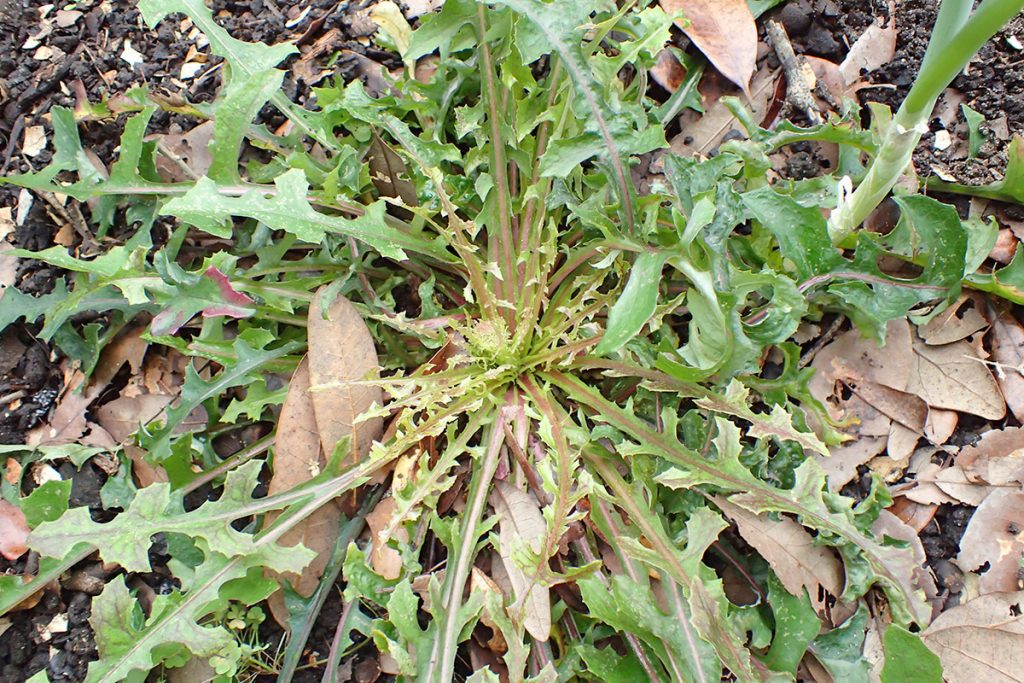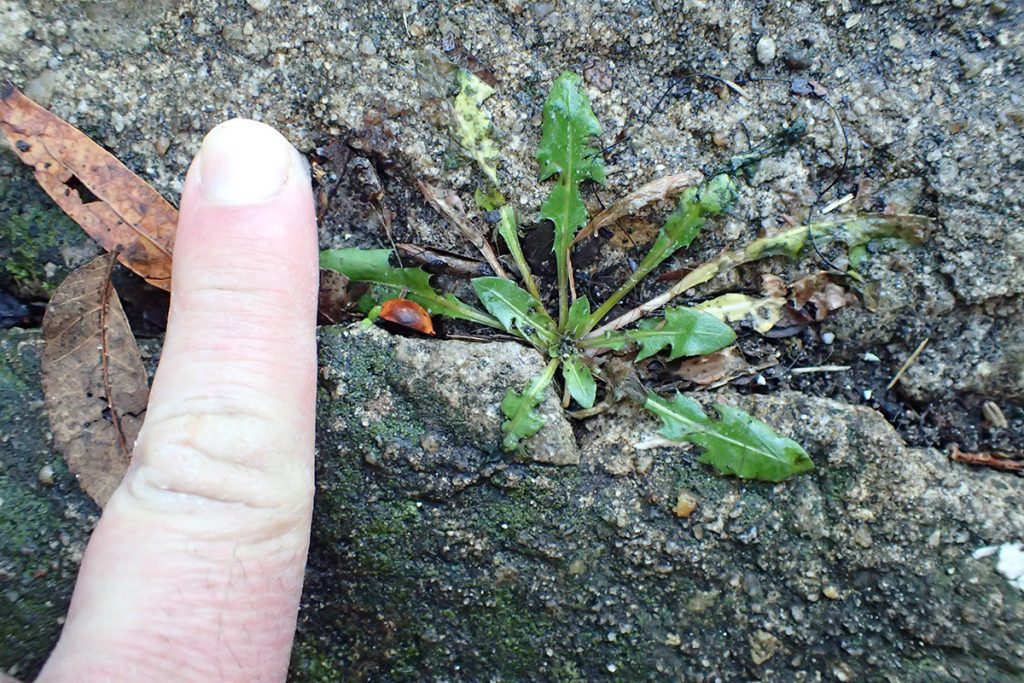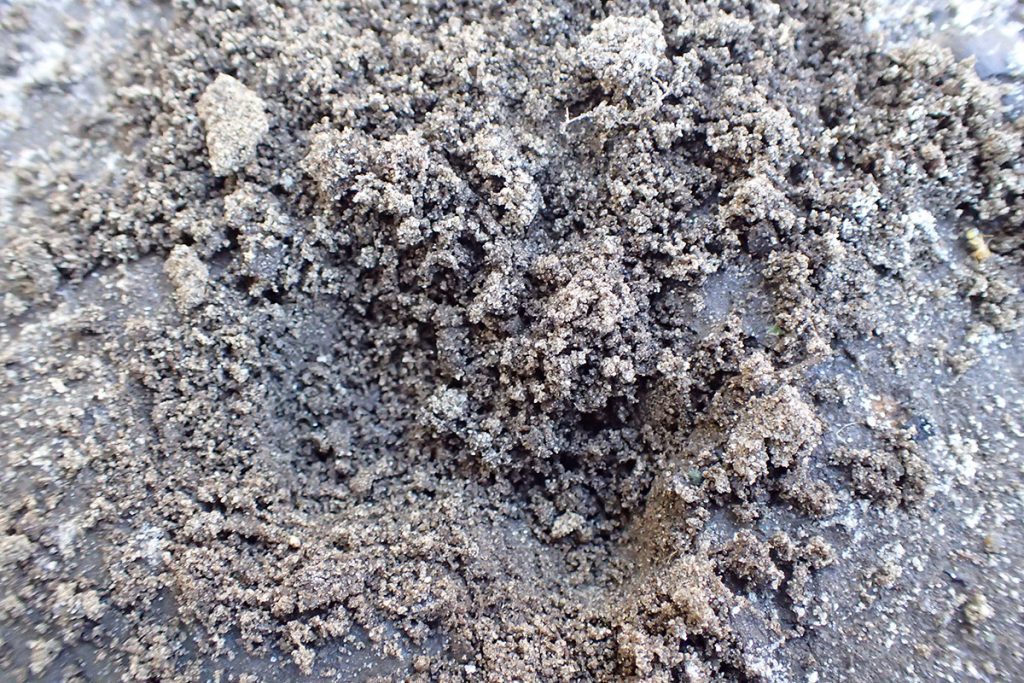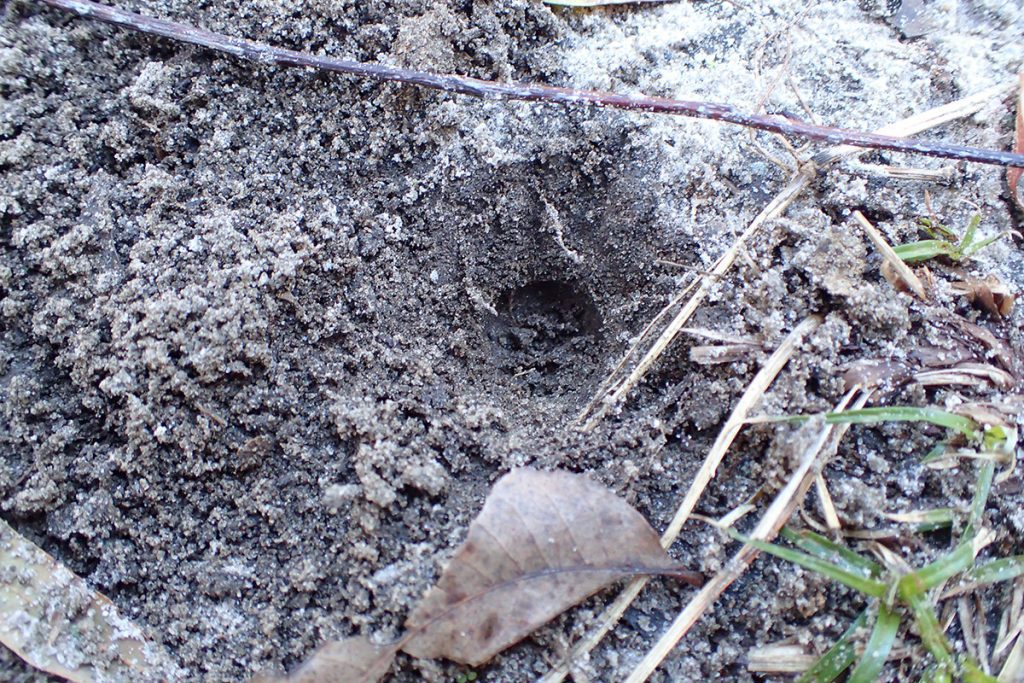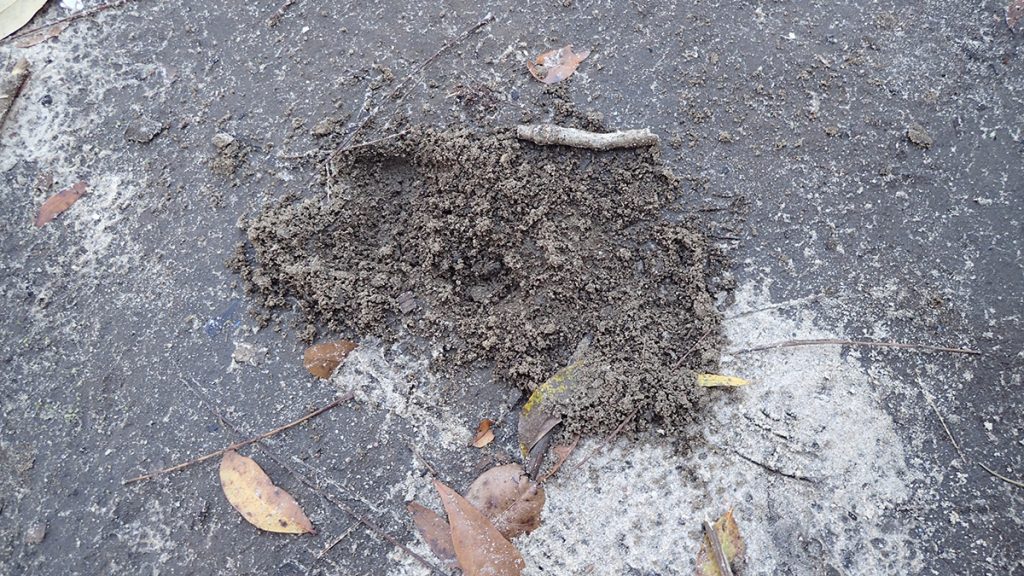Most years, we leave town to visit family for the holidays. Also most years, we take some sort of summer vacation. This isn’t most years. We didn’t travel, and Amy, the kids, and I are all here in the house together working and schooling. I don’t have to say it was a year unlike any other, all of us experienced that in our own way.
Anyhow, I was home. And more than I’ve ever been able to before, I watched the yard. I watched it without interruption, from the beginning of spring through the freezing of the bird bath in December. I’ve taken a lot more photos, spent more time inspecting weeds and seeing insects do things I’d never before seen.
So here’s the final Backyard Blog of a different kind of 2020, with no gaps over Thanksgiving and Christmas.
November 5, 2020
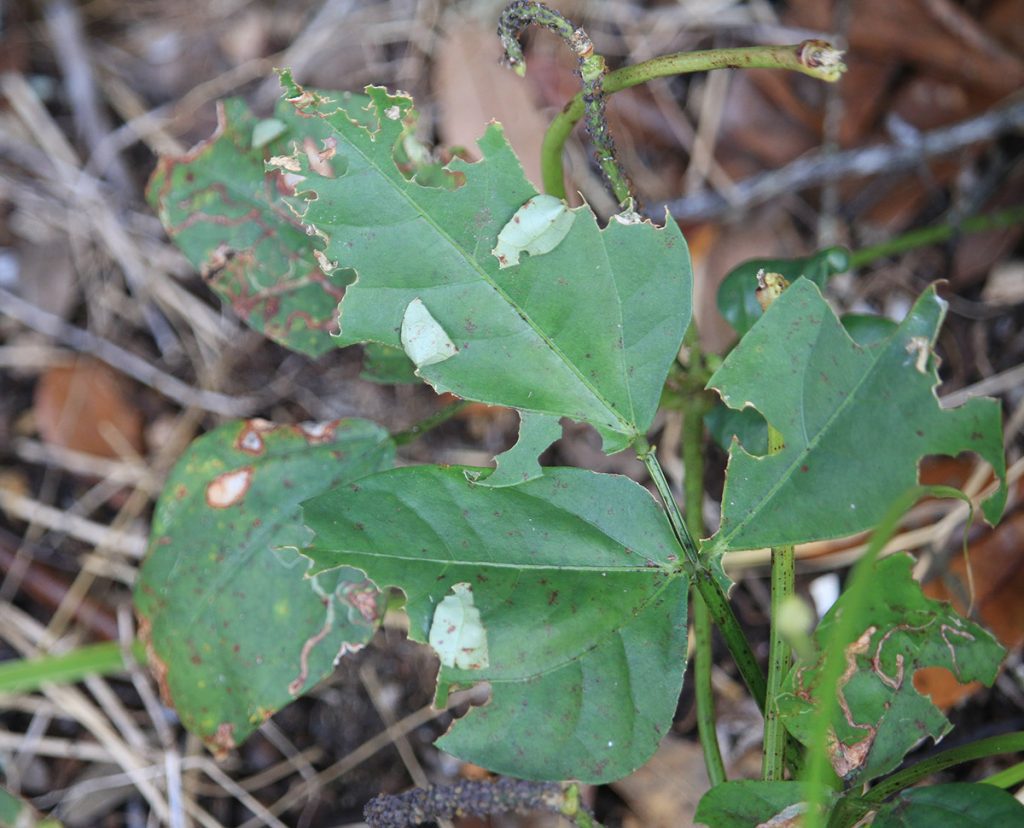
I was getting ready to pull the bean plants and get this raised bed ready for winter veggies, when I noticed the small folds in the leaves. Long-tailed skippers are still active in the yard, and these folds are evidence of one more round of their caterpillars for the year.
I looked up whether long-tailed skippers overwinter as a pupae, as many butterflies do. They actually overwinter as adults, heading for warmer weather when temperatures drop. I left the plant alone, to give the caterpillars the chance to mature while it was still relatively warm.
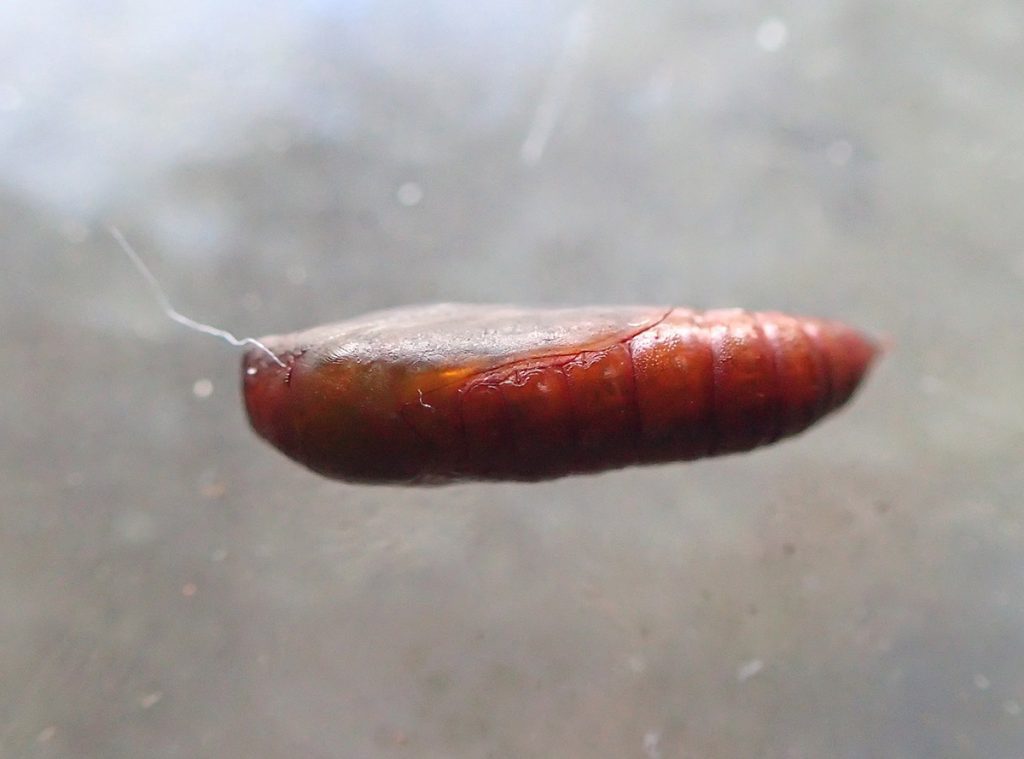
I found this in some leaves. It’s a moth chrysalis, and if you Google moth chrysalis, you’ll see that many species have ones similar to this. Leaf litter is full of larvae and pupae, many of which overwinter there.
November 6, 2020
You never know when you see a certain bee or butterfly for the last time in any given year. I had that in mind this first Friday of November, as I saw a few pollinators on the last of our flowers.
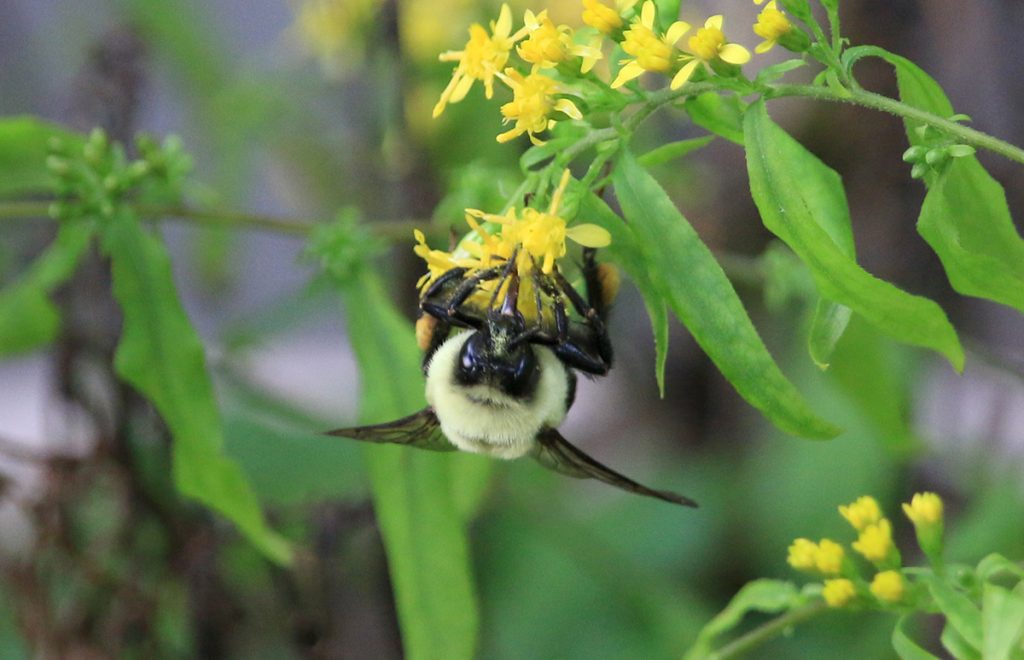
I’m still seeing a lone bumblebee in the yard. iNaturalist observations for Eastern bumblebees drop off steeply between October and November. This is when their colonies die off, and new queens leave to mate; they will then find a place to lie dormant until spring, when they will lay their eggs and start a new colony.
This bee is gathering nectar from goldenrod, that important fall nectar source for the pollinators still flying. I won’t see another bumblebee after this week.
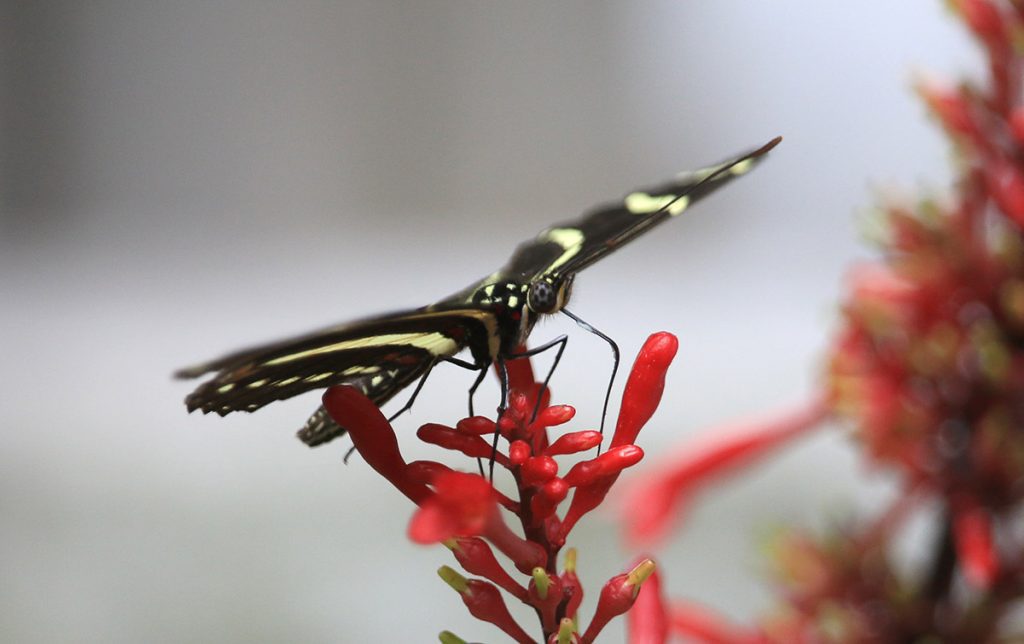
Here’s another fall blooming flower, feeding a zebra longwing. I had also been seeing bumblebees on the cardinal guard, the only year I’ve seen them on the plant. The long, tubular flowers are better suited for butterflies with long probosces, and long-billed hummingbirds. But then, I’ve been noticing bumblebees trying a lot of different flowers as a lot of their usual sources die off for the year.
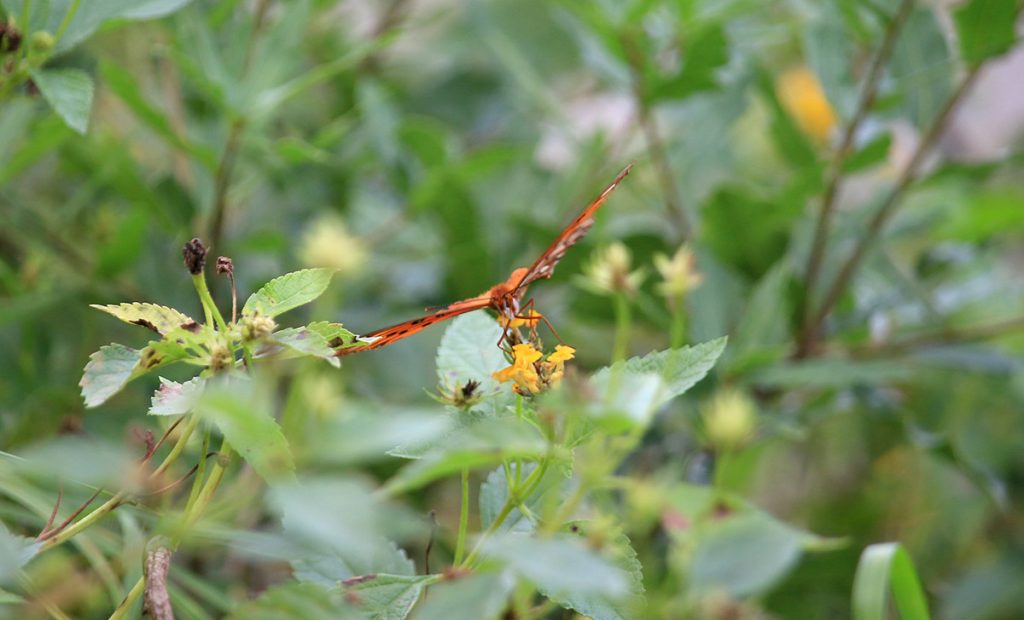
I’ve been curious about overwintering butterflies, so I look up both of the species I saw this day. Zebra longwings and gulf fritillaries both migrate, but gulf fritillaries will also overwinter as caterpillars or chrysalides.
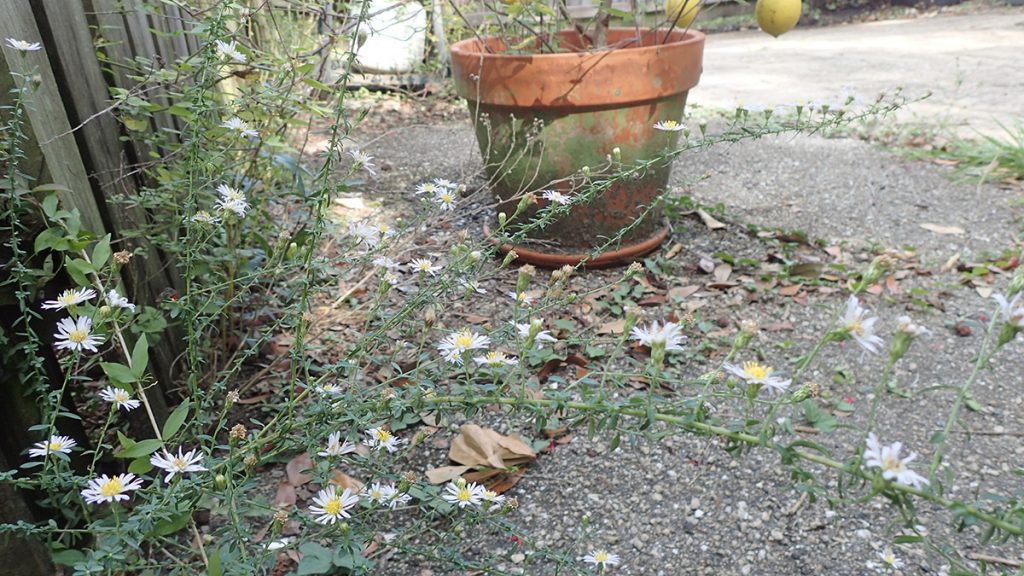
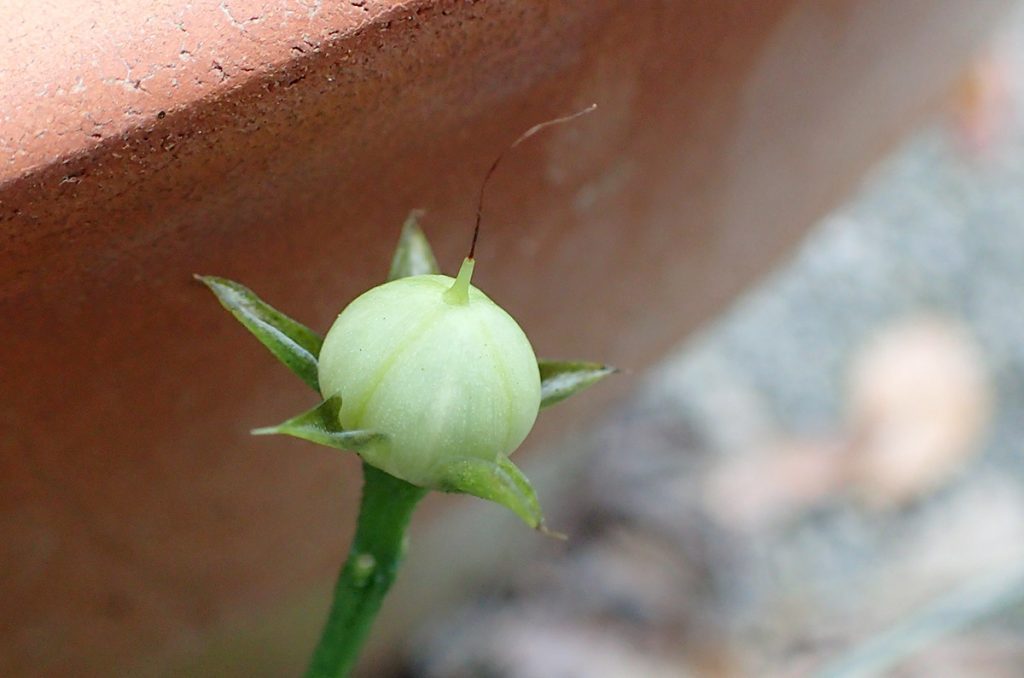
A couple of signs of seasonality in our yard. One is the rice button aster, which has been volunteering in our yard over the last few years. Catclaw vine and scarlet sage have taken over their usual spot, and so I only have a couple of scattered plants this year. Soon, I’ll put a lot of work in to take care of the invasive catclaw vine.
The tievine is new in the yard this year. I first spotted it in the summer, and it flowered in the early fall. Here it has made fruit.
November 7, 2020
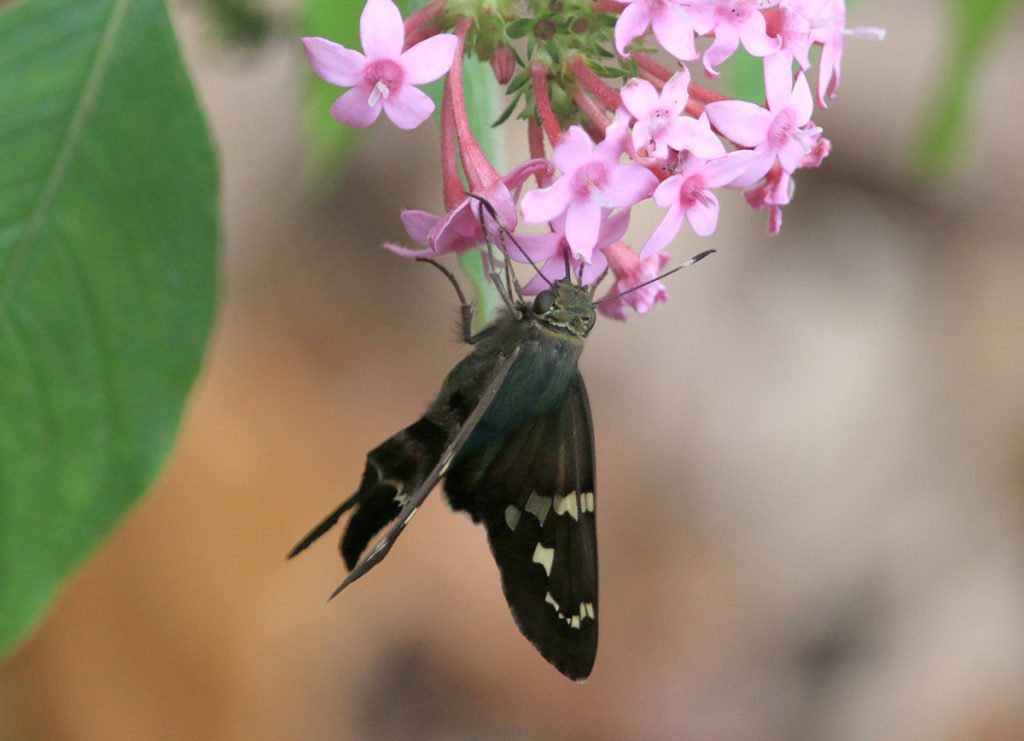
Soon, I won’t see any adult long-tailed skippers in the yard. They did leave those caterpillars on the bean plant, though.
November 9, 2020
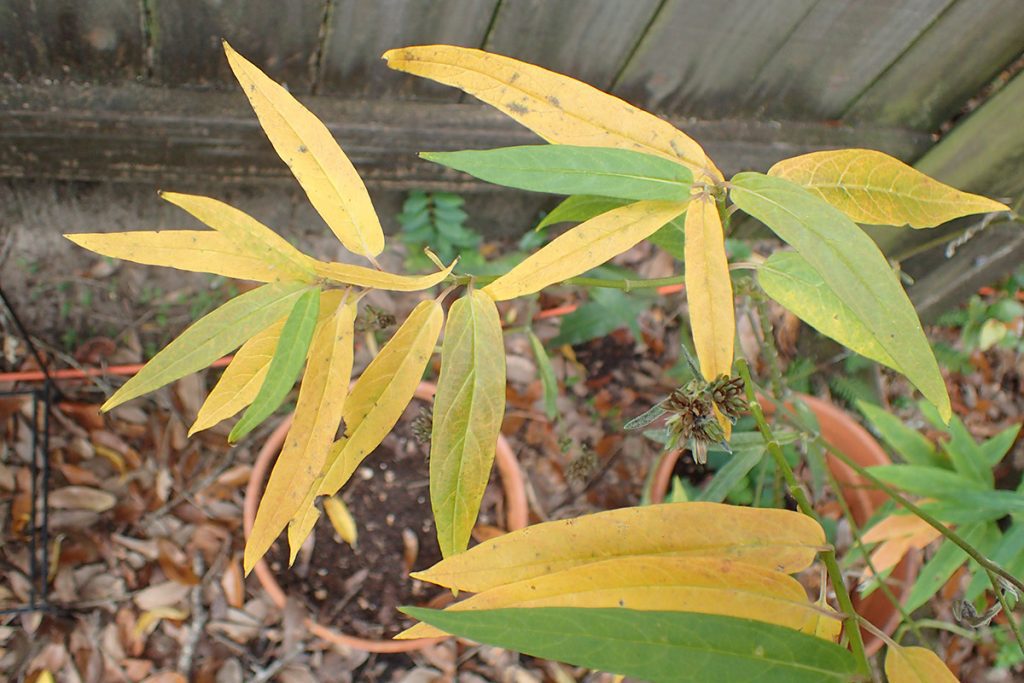
I had previously read that you cut your nonnative tropical milkweed (Asclepias curassavica) back after Thanksgiving. Their leaves won’t die off unless there’s extreme cold, which lets the monarch killing OE build up on them. More recently, I’ve seen where you should cut back the Curassavica earlier. This native milkweed (mixed in with Elaphantopus gone to seed) is giving me guidance on when to cut. Its leaves are starting to drop, and so the nonnative milkweed should follow suit and lose its leaves.
As we learned in our milkweed segment from a couple of years back, aquatic milkweed (Asclepias perennis) is the only Florida native milkweed to keep its leaves over winter. Both of our perennis plants kept their leaves throughout the year.
November 10, 2020- An Invasive Species Makes an Appearance
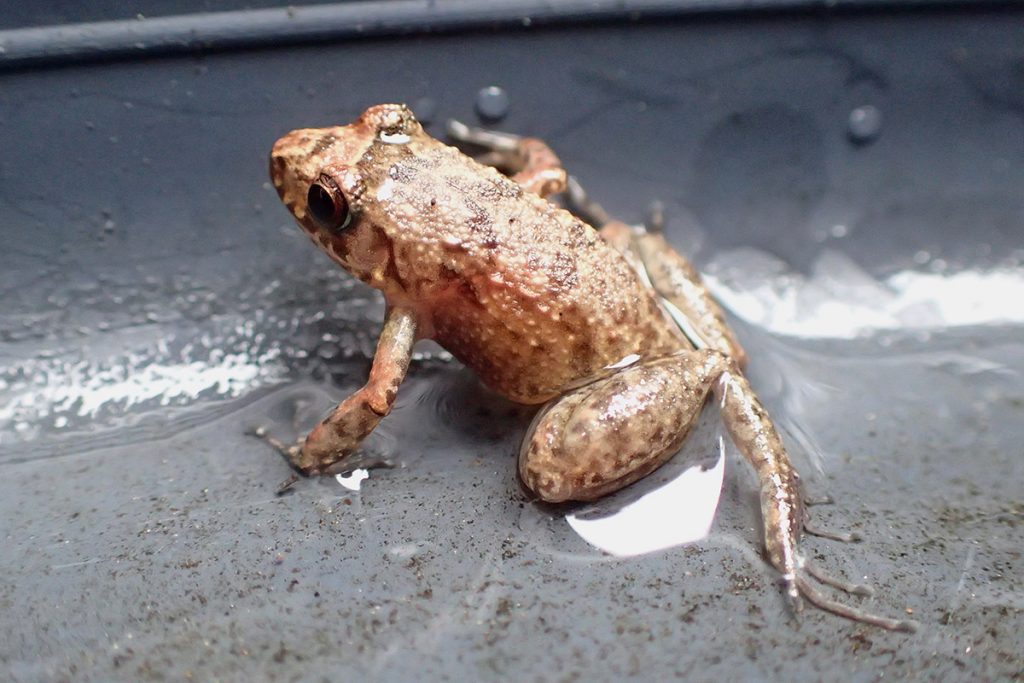
This is what I get for waiting to iNaturalize animals I see in the yard. Like many of the lizards we see in our yards in Florida, as well as the invasive Cuban Tree Frog, the greenhouse frog is a Cuban import.
I found this one while moving some pots in the yard. This is where I find frogs later in the year, hiding under stacks of empty pots in the side yard.
Generally, I like reptiles and amphibians in the yard. But how do these newly arriving species affect the natives already here? How will they affect the balance of the backyard food web?
November 11, 2020
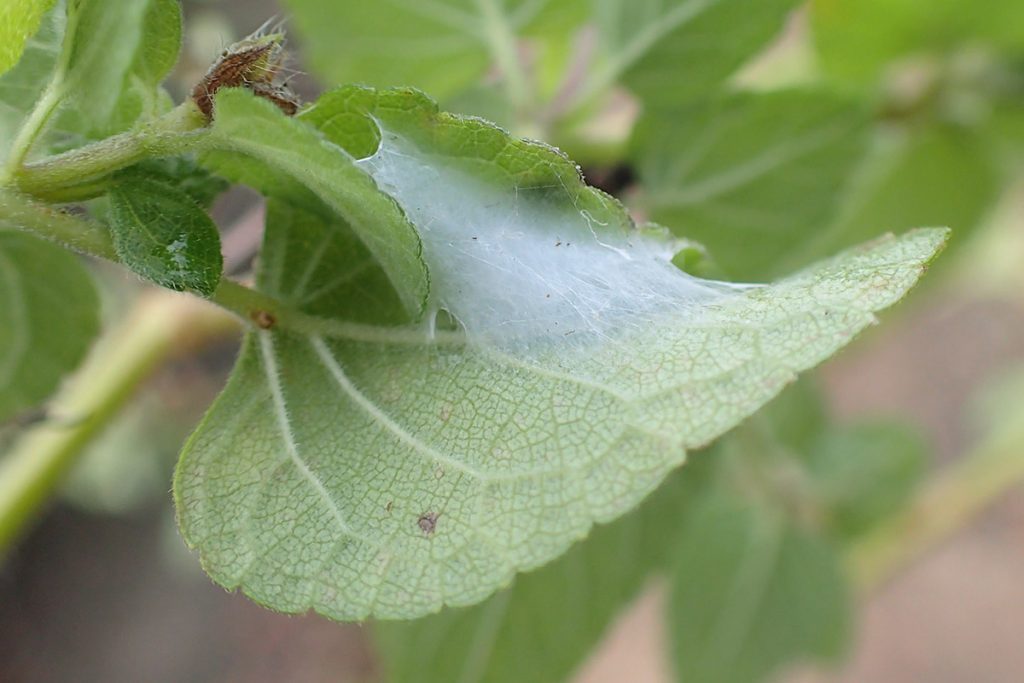
Here’s an insect nest between two leaves. This looks similar to a cabbage looper cocoon, but other moths do this as well.
November 13, 2020
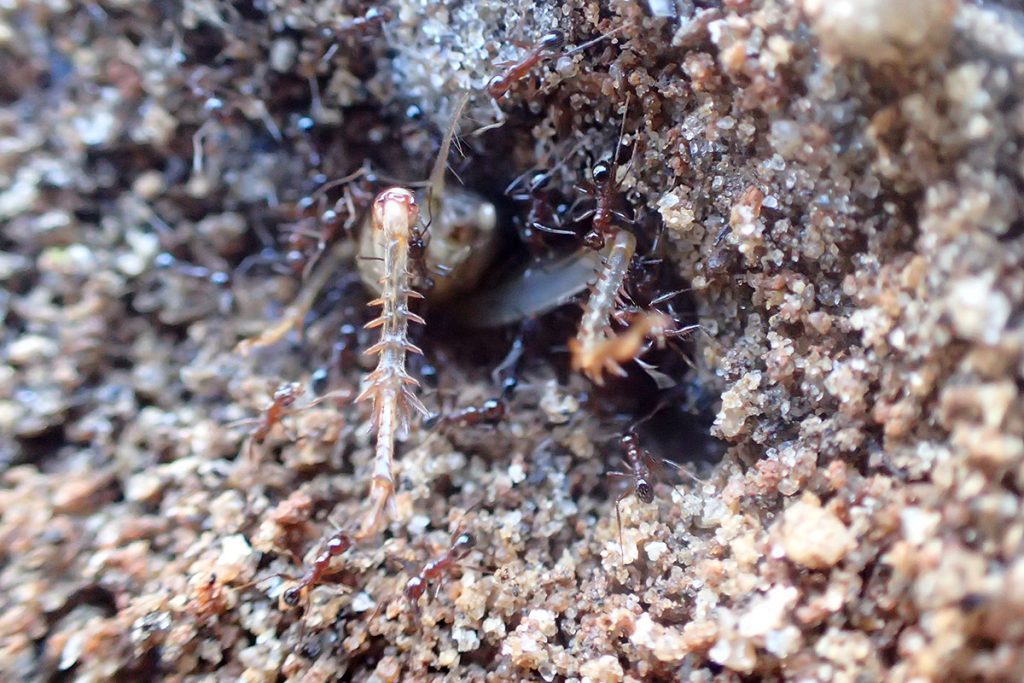
We have this small fire ant nest in a crack in the pavement. I don’t see much of them in the yard, aside from the occasional attempt to ambush small bees. Here, they seem to have snagged a grasshopper.
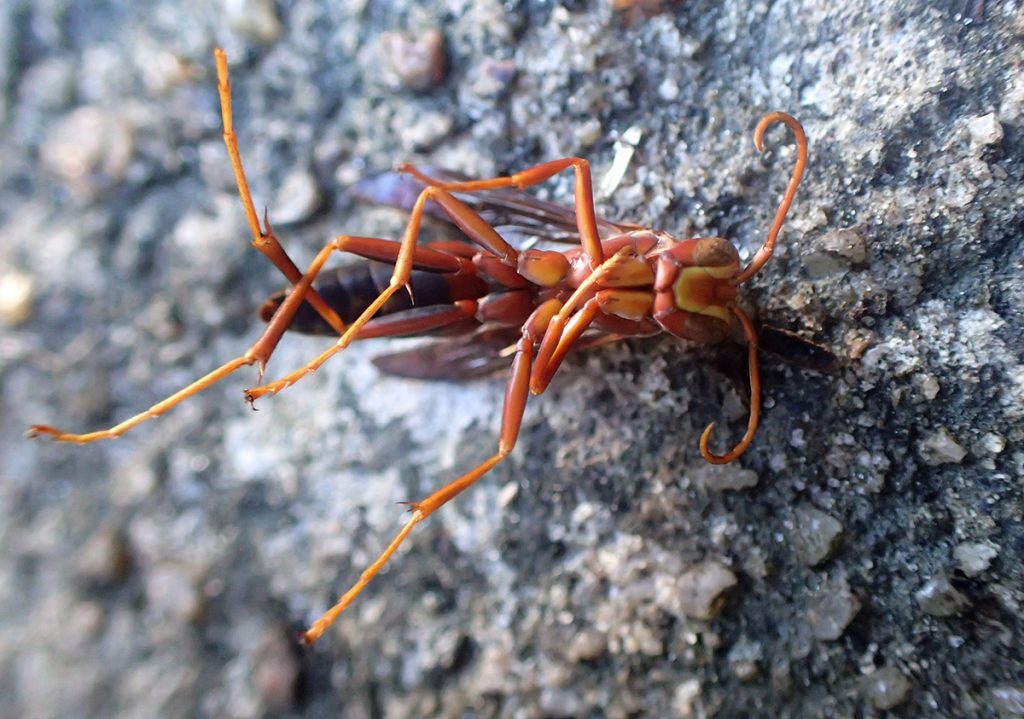
I imagine the grasshopper was already dead when the ants found it. Many insects don’t live through the winter as adults. Adults die, leaving eggs, larvae, or pupae in a place where they’re more likely to survive the elements, and hopefully predation. Here’s another dead insect I saw that day, a metric paper wasp.
November 15, 2020
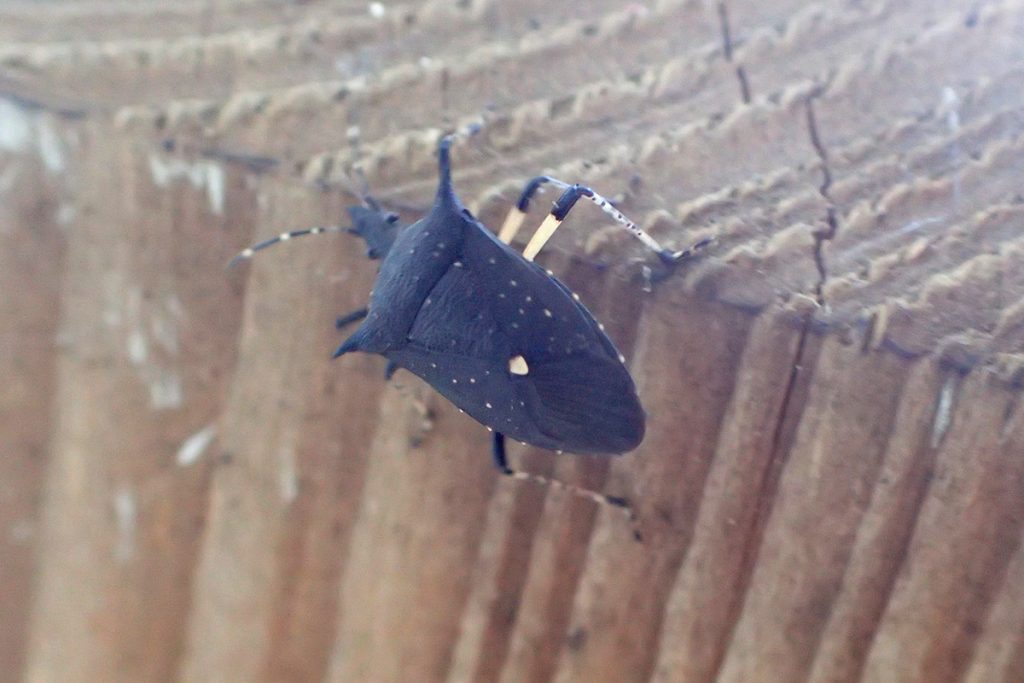
I didn’t get a great photo of this stink bug as it ran away from the camera. It would have been better if I had the DSLR handy, and didn’t have to move in to try and take a photo.
November 29, 2020
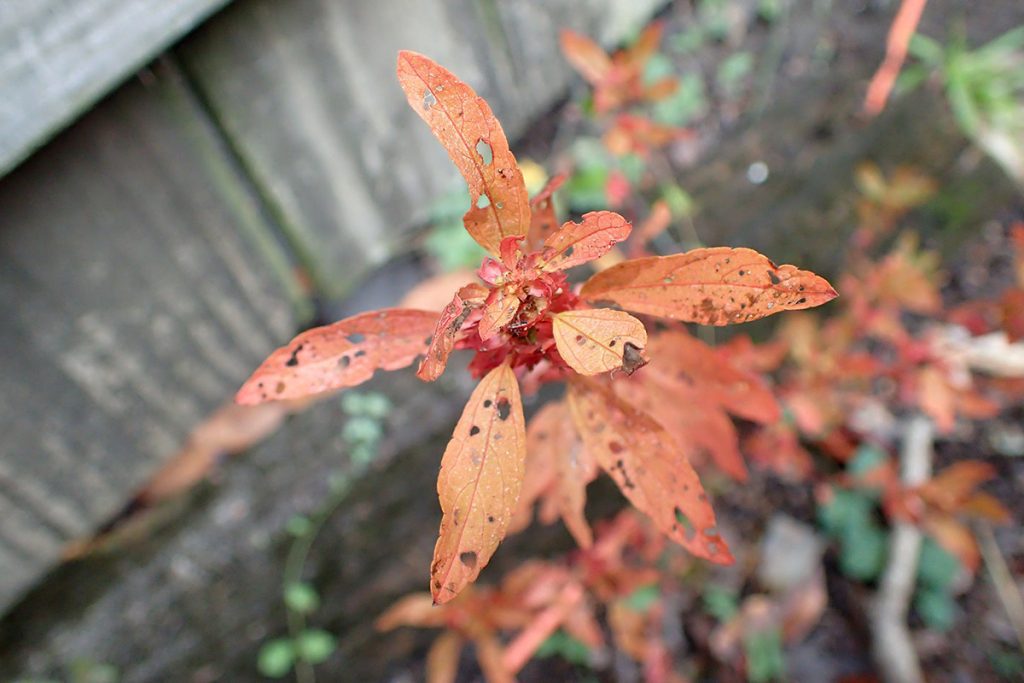
Here’s a plant I learned about earlier in the year, the slender three-seeded Mercury. It looks like insects have enjoyed eating it, which is why I let native “weeds” grow in the yard. I included this plant on my post on incorporating weeds into your Florida friendly landscape. This plant turns a spectacular color in the fall, as we see here.
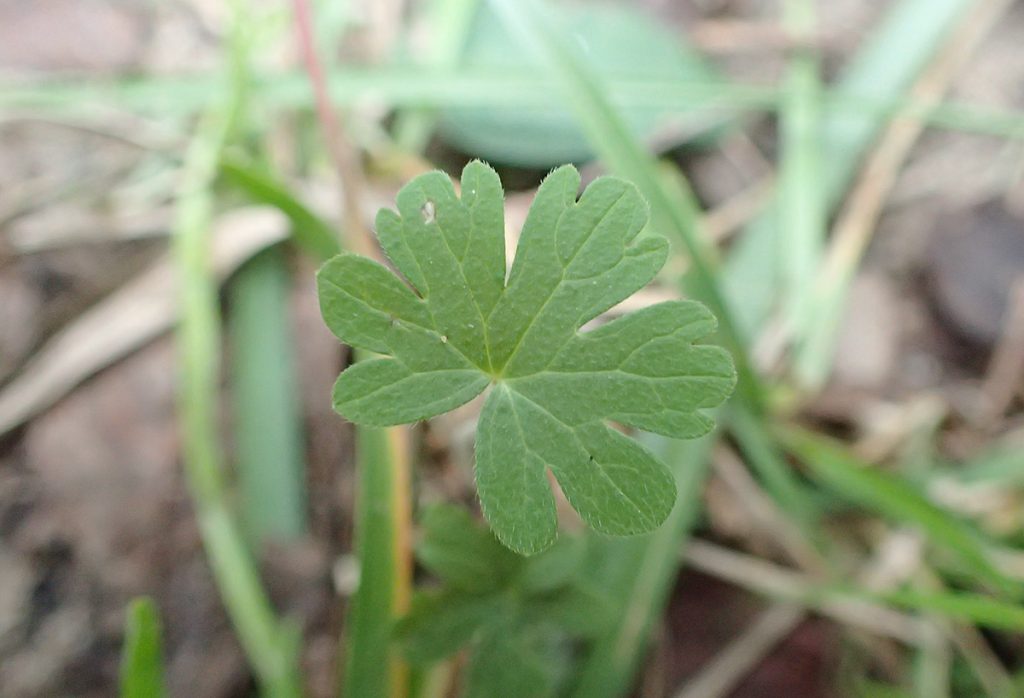
Here’s a native geranium popping back up in the yard. I saw it the week before on a hike in Elinor Klapp-Phipps Park as well. Before that, I hadn’t seen them since early spring, which is when they finish flowering. In March, they went to seed, and the seeds are evidently appetizing to squirrels.
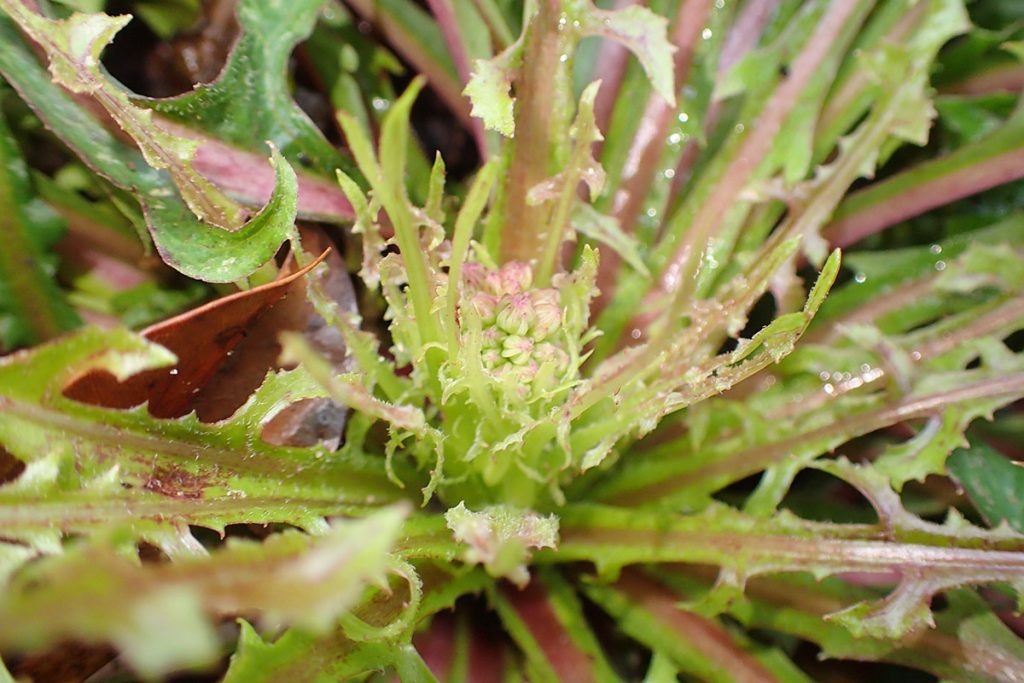
I figured this was related to dandelions, but was surprised when iNaturalist (and a reputable botanist user) suggested it was a common dandelion. Not long after, I heard dandelions used as an example of plasticity in plant characteristics. On the In Defense of Plants podcast, Matt, the host, talked about how dandelions can flower even when mowing keeps them small, but that they can become large as well.
A dandelion growing a few feet from this one illustrates this plasticity:
And lastly, I’ve been tackling catclaw vines in the yard.
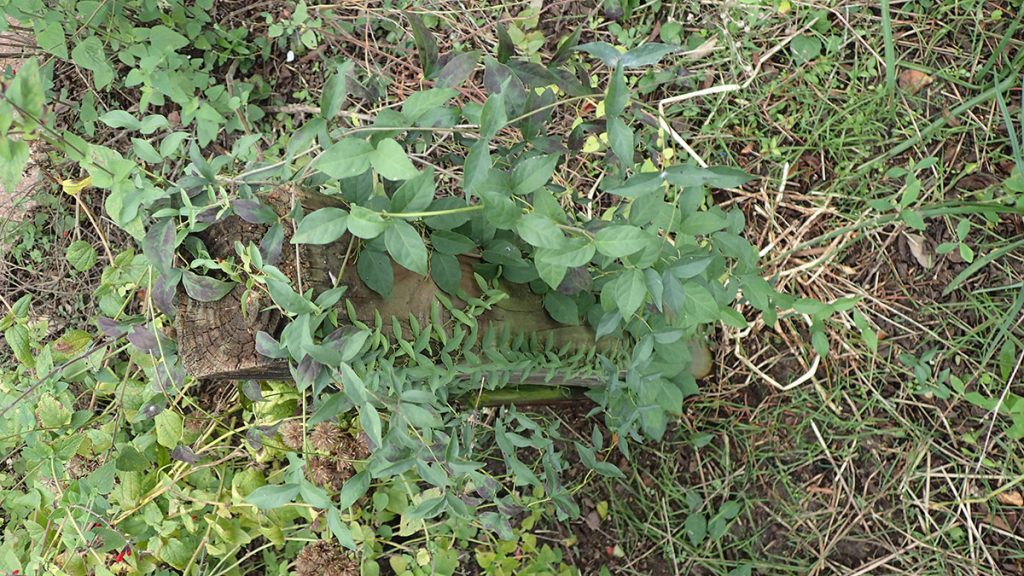
When I have time, I may write a separate piece about removing the vine. I started noticing a lot of it on the fence, even after removing some over the summer. When I went to pull it up, I realized it crossed over the ground as well, dropping tubers to root it along the way. I have so many digging and tuber photos, too many for this post.
December 3, 2020
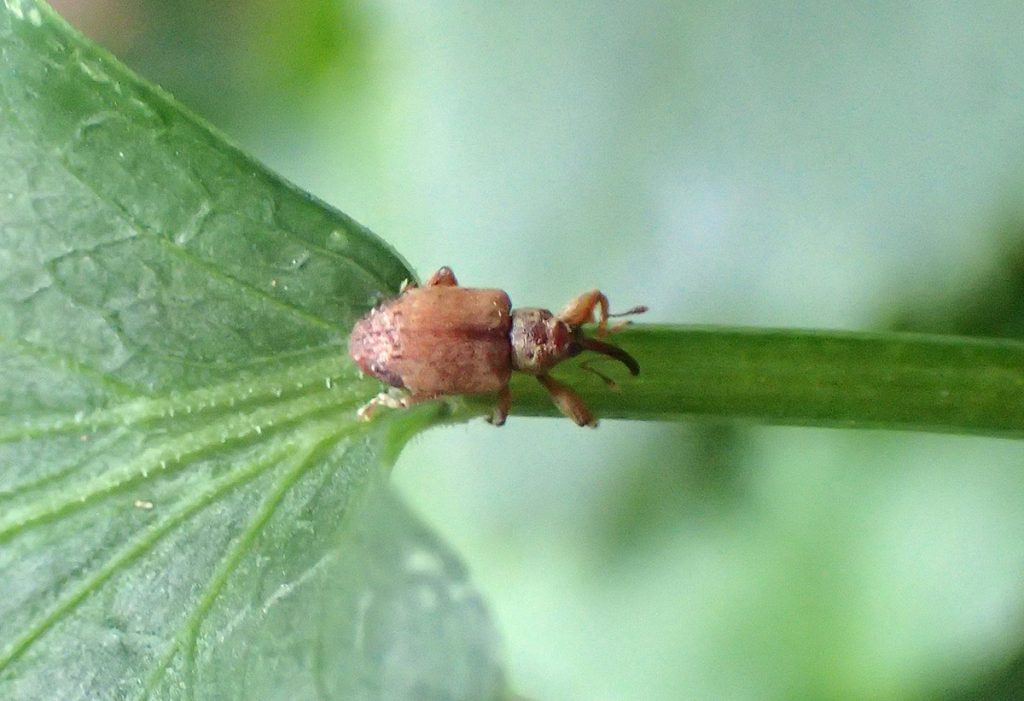
This is a leguminous seed weevil, per its description. We grow peas (legumes), and this insect consumes the peas inside their pods.
December 4, 2020
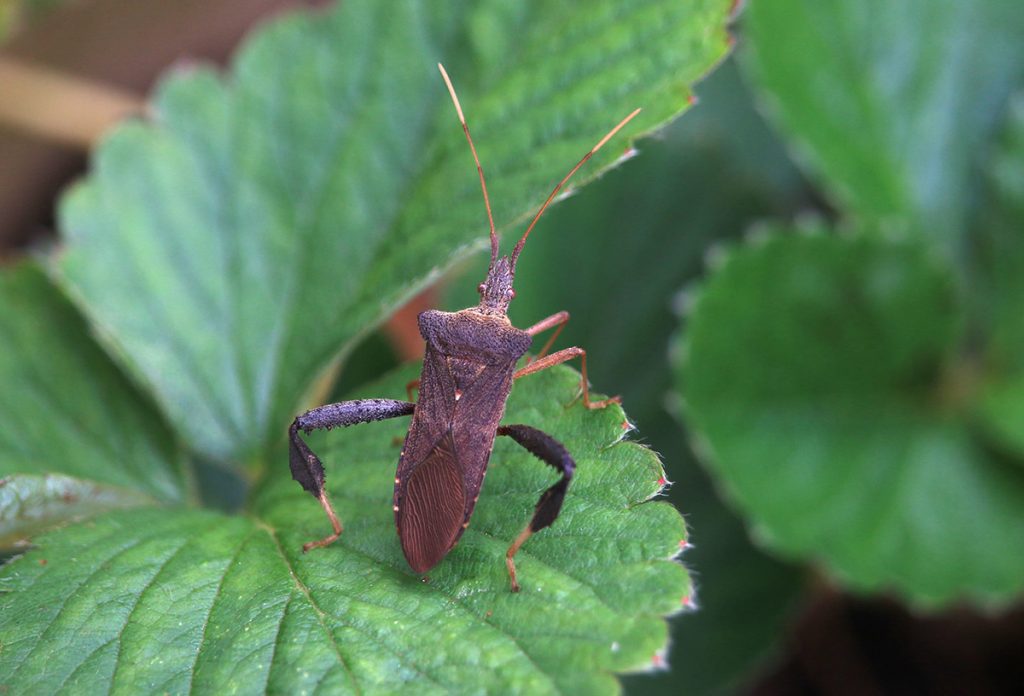
Another insect with no common name. This is a leaf footed bug that specializes on magnolia fruit. We don’t have any in our yard, but magnolias are never far in Tallahassee.
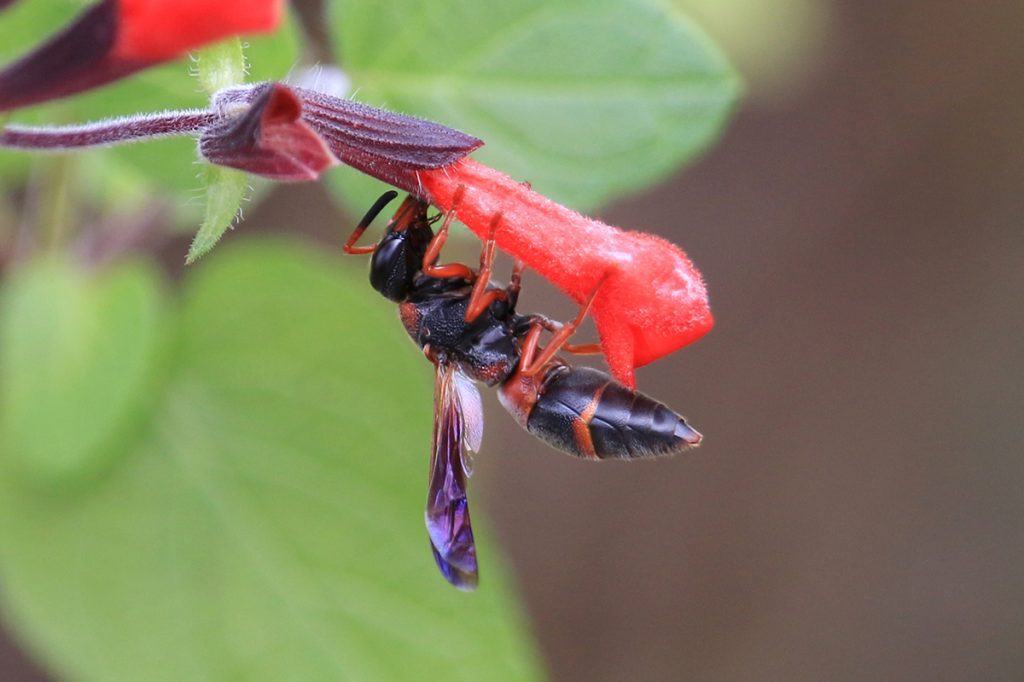
This is a common wasp in our yard, here seemingly taking nectar from the base of the flower, like carpenter bees are known to do. On the warmer December days, I’ve also seen paper wasps inspecting the leaves of the cherry laurel trees. I imagine they’re hunting for insects to feed their young.
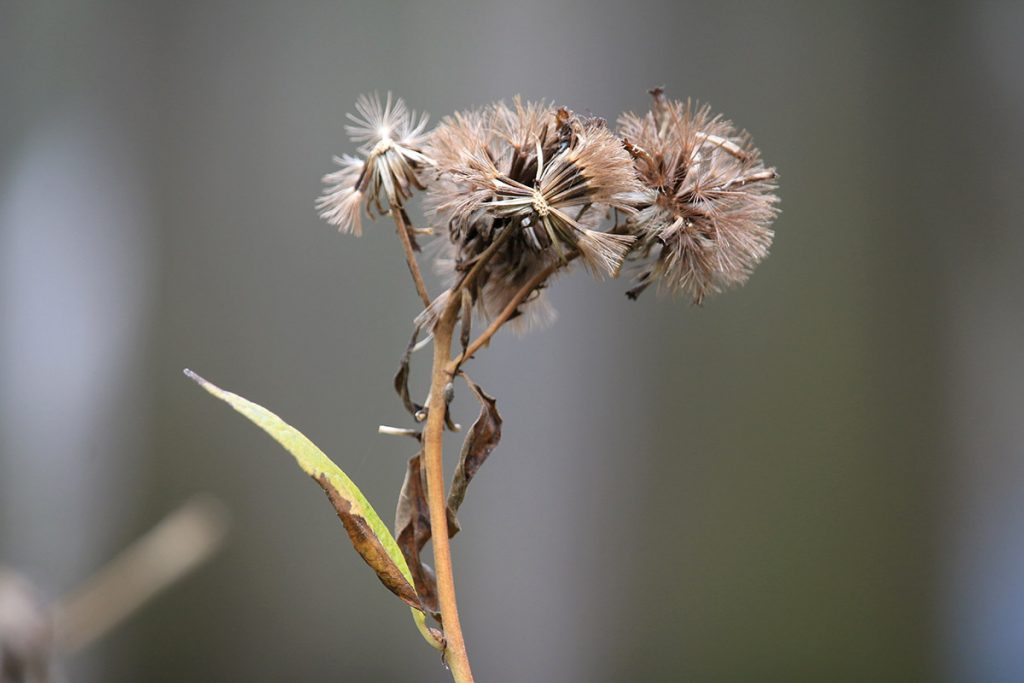
These flowers were popular with larger butterflies in moths in September. I like to leave seedheads alone. Maybe they’ll re-seed like the scarlet sage. Or maybe they’ll feed birds. I am noticing a lot of new sage plants growing under older plants that have gotten large and woody. The loosestryfe is also large and woody, and it’s starting to sprout new growth from its roots. I’ve started cutting back some of these older wildflowers, to make space for the new growth, but also leaving some of the older growth for the insects that might overwinter in it.
December 5, 2020
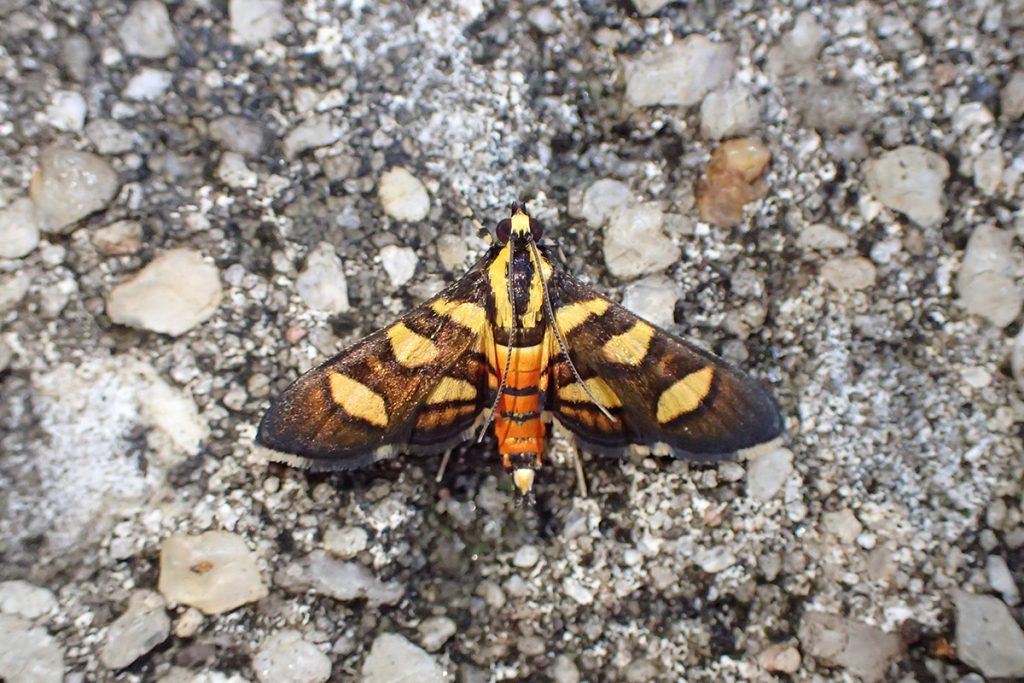
I saw this attractive moth walking around on the pavement. The fact that it let me lean in close with a camera makes me think it was dying, as many adult insects do in the fall.
I looked it up and found that its caterpillars feed on Rubiaceae. I wasn’t familiar with this plant family, so I searched iNaturalist for Rubiaceae in Leon County to see what plants we had locally. One is partridgeberry, one of my favorite plants on our shady slope trails. Another is Florida Pusley, which grows in our yard.
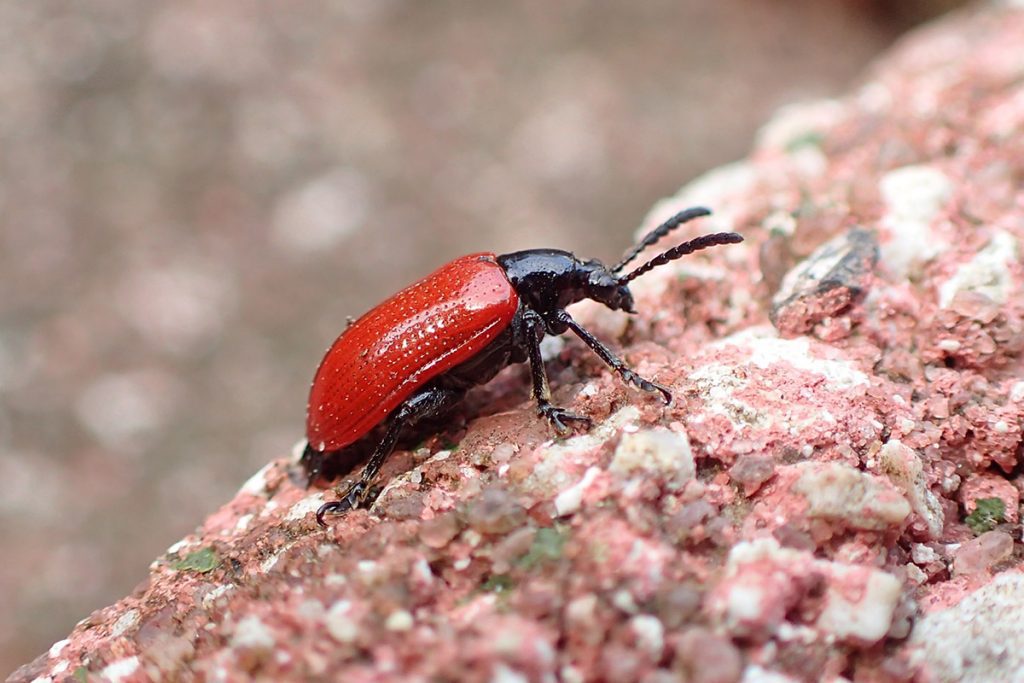
Here’s an interesting insect. It’s a nonnative introduced by biologists in 2012 to consume invasive air potato plants. In September, we saw polka-dotted wasp moths in our yard, and their caterpillars eat air potato plants as well. Air potatoes are not in our yard, but I imagine there are plants nearby.
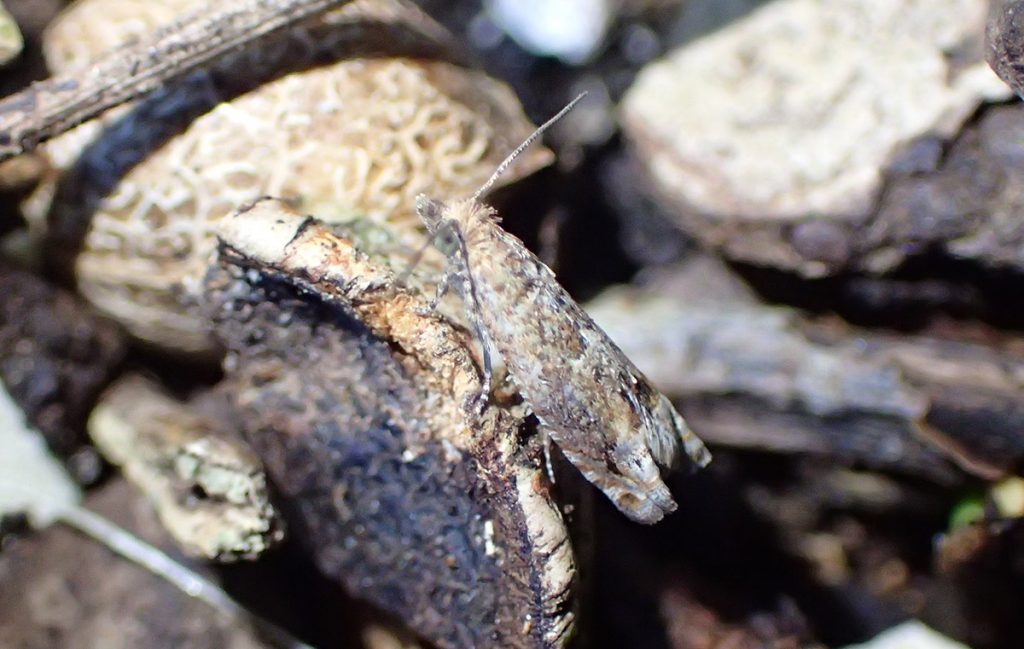
I don’t usually have a ton of luck IDing little brown moths in iNaturalist. This was a top suggestion, and I did see a leaf roller caterpillar earlier in the year.
December 11, 2020
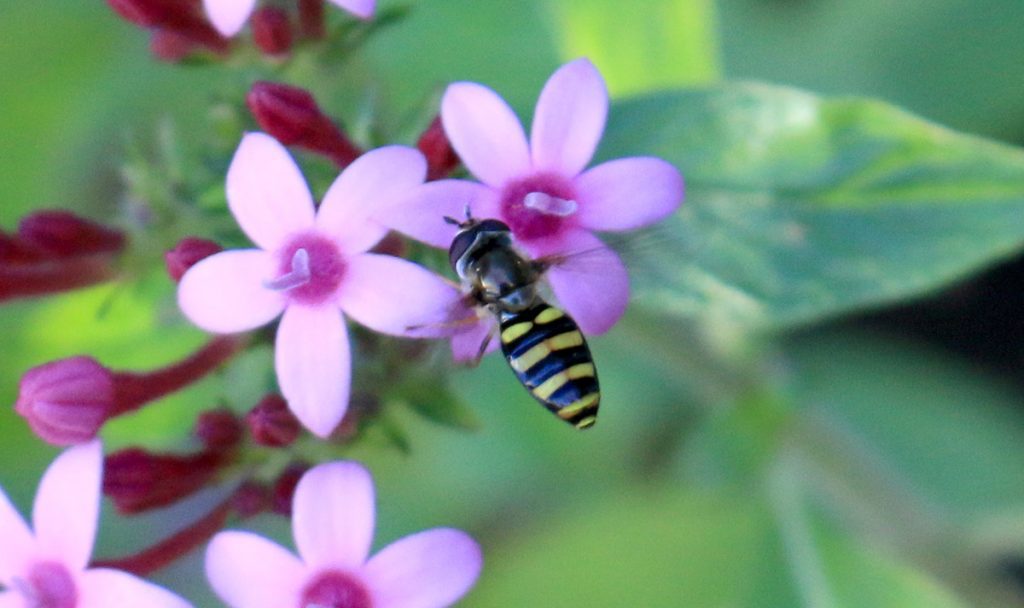
I hadn’t seen a hoverfly in a while, so this was a welcome sight. It’s a species of hoverfly I haven’t previously seen in the yard. For those unfamiliar with them, hoverflies, or syrphid flies, are pollinators that mimic bees and wasps. And their larvae eat aphids. They’re always welcome here.
December 12, 2020
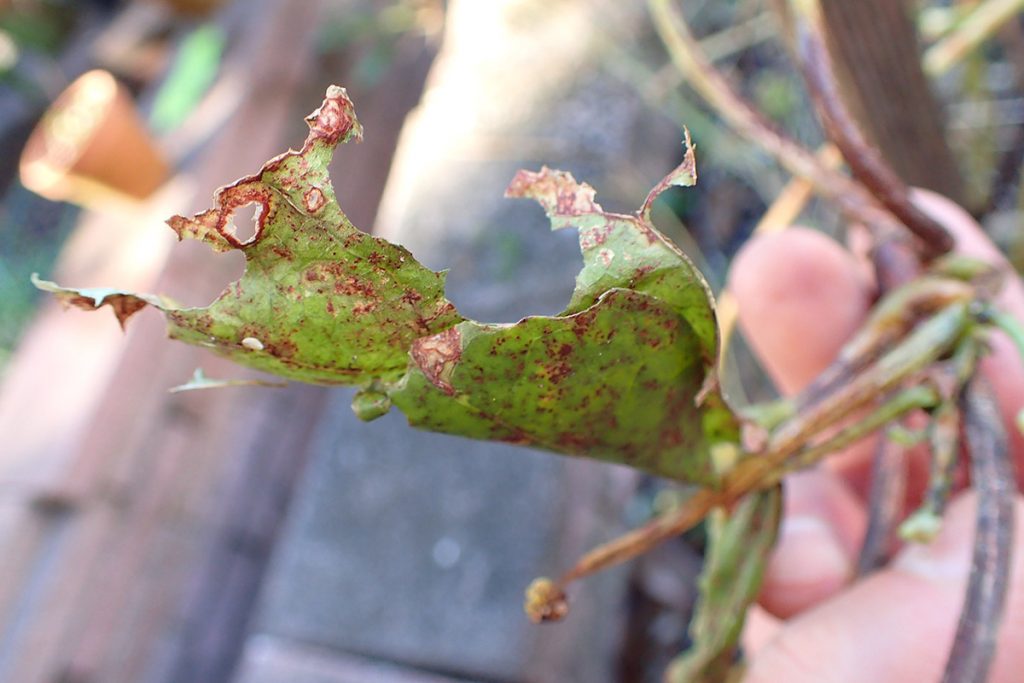
It’s been over a month since I noticed that long-tailed skipper caterpillars were eating a dying bean plant. I left it alone to let them grow, and now, over a month later, I see one of its few remaining leaves with a larger curl. So I look inside as best I can without disturbing the caterpillar:
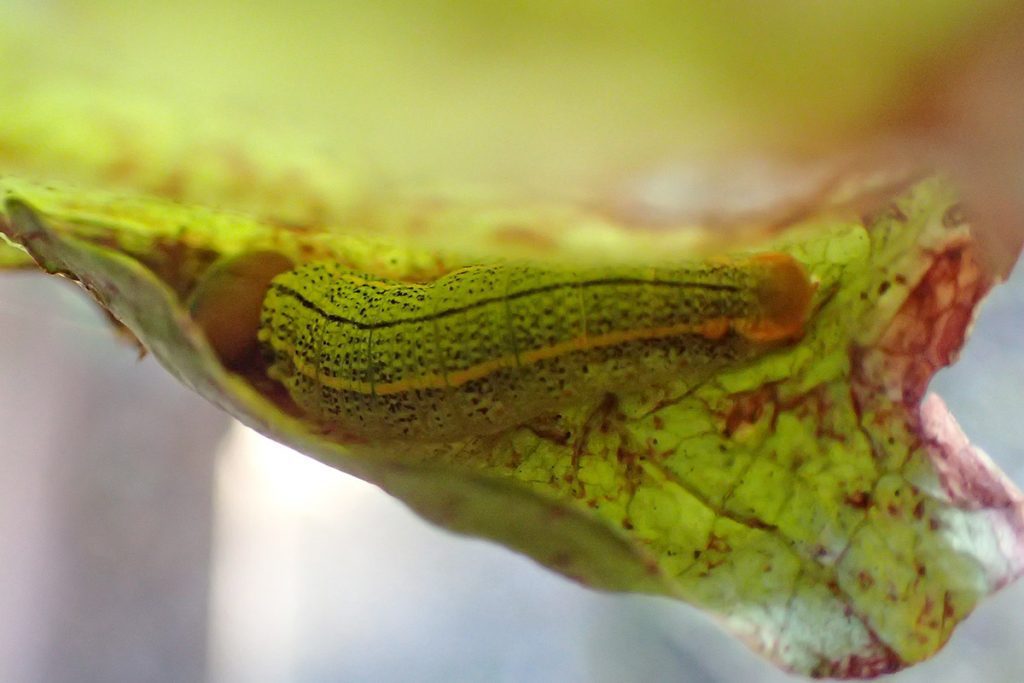
It’s large with a thick yellow stripe- a late instar caterpillar close to making a chrysalis. Or is it? Temperatures have dipped into the thirties here, and this is a species that migrates away from the cold rather than overwinter as a caterpillar or chrysalis. It seems to be hanging on, but for how much longer?
December 18, 2020
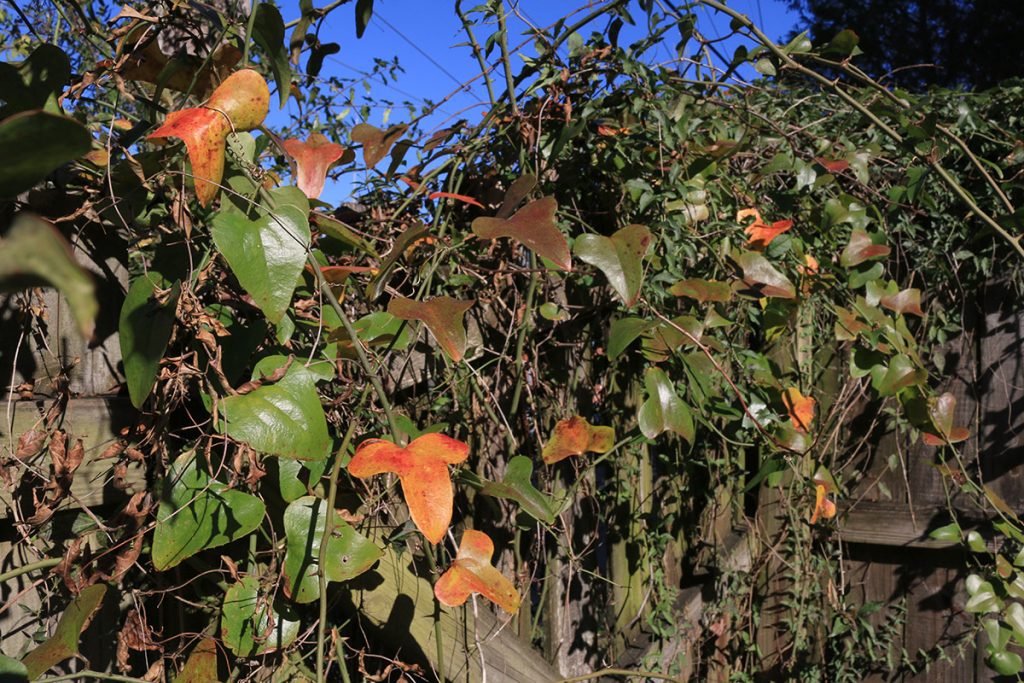
A little bit of fall color on this smilax vine.
December 22, 2020
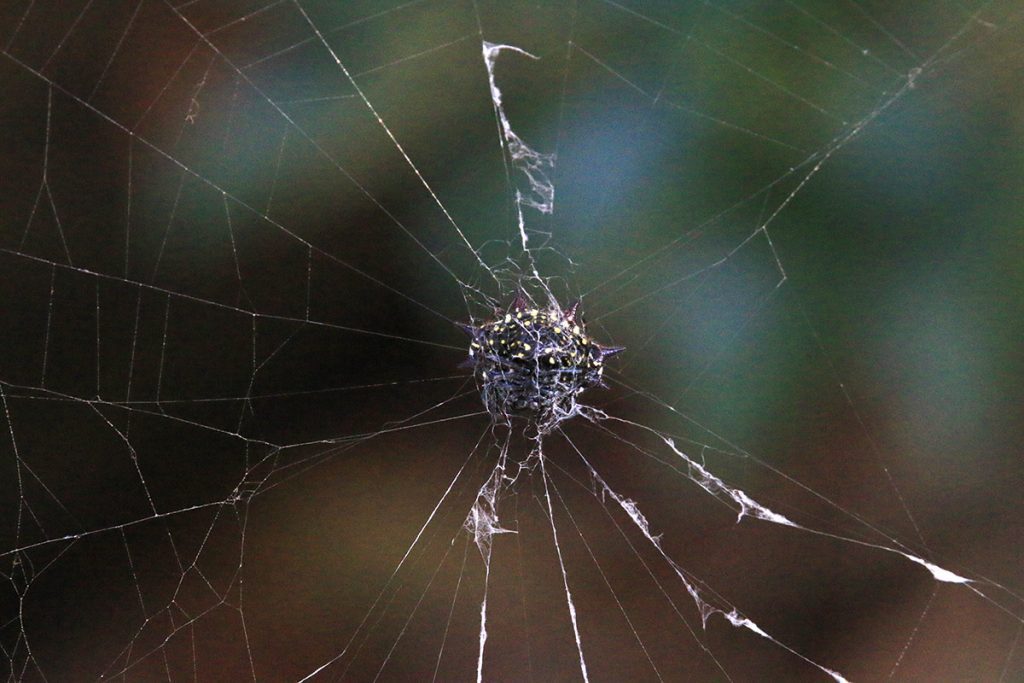
Saw this spinybacked orbweaver after it started getting dark.
December 27, 2020
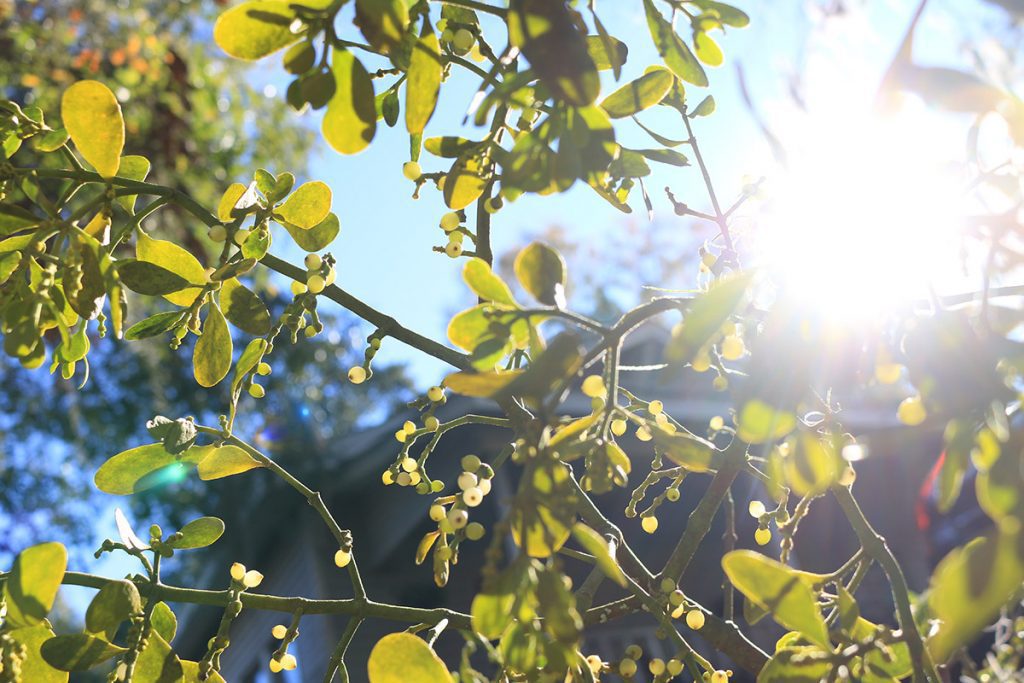
My wife asked me if I’d seen the big branch that had fallen in front of my car. It’s not uncommon for a strong wind to knock a branch off of our pecan tree, but she said this one looked different. I went out and looked, and saw this lovely native mistletoe.
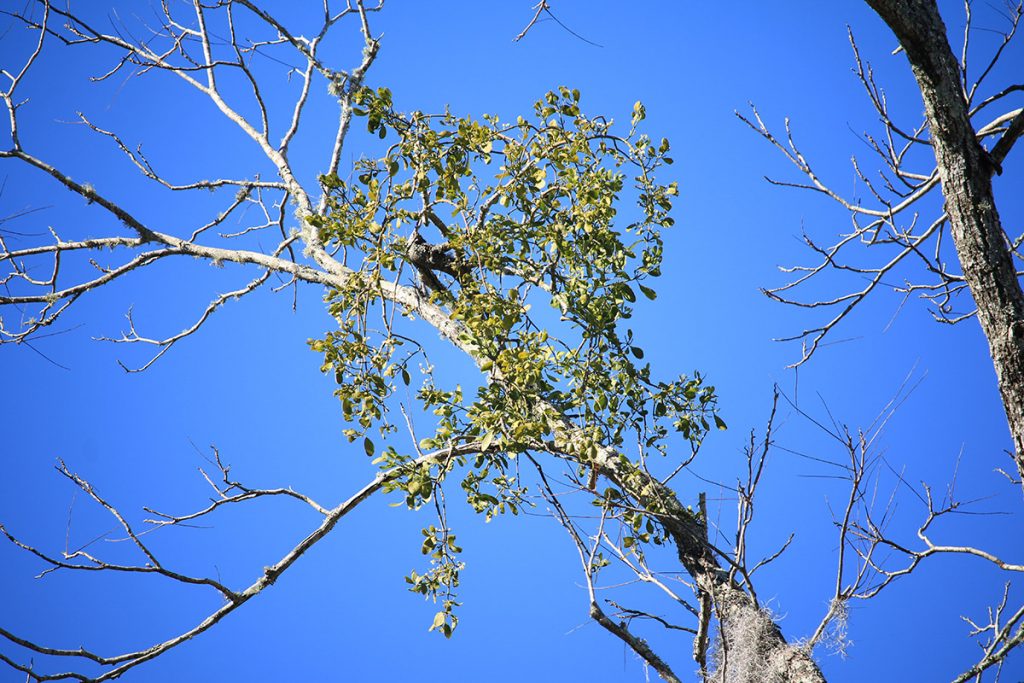
I looked up to see where it came from. As we learned a couple of years ago, mistletoe is a hemiparasite that grows on other trees. A deciduous tree that drops its leaves will let plenty of sunlight onto the mistletoe, which flowers and produces fruit in the winter months. And indeed, there it was in our leafless pecan tree.
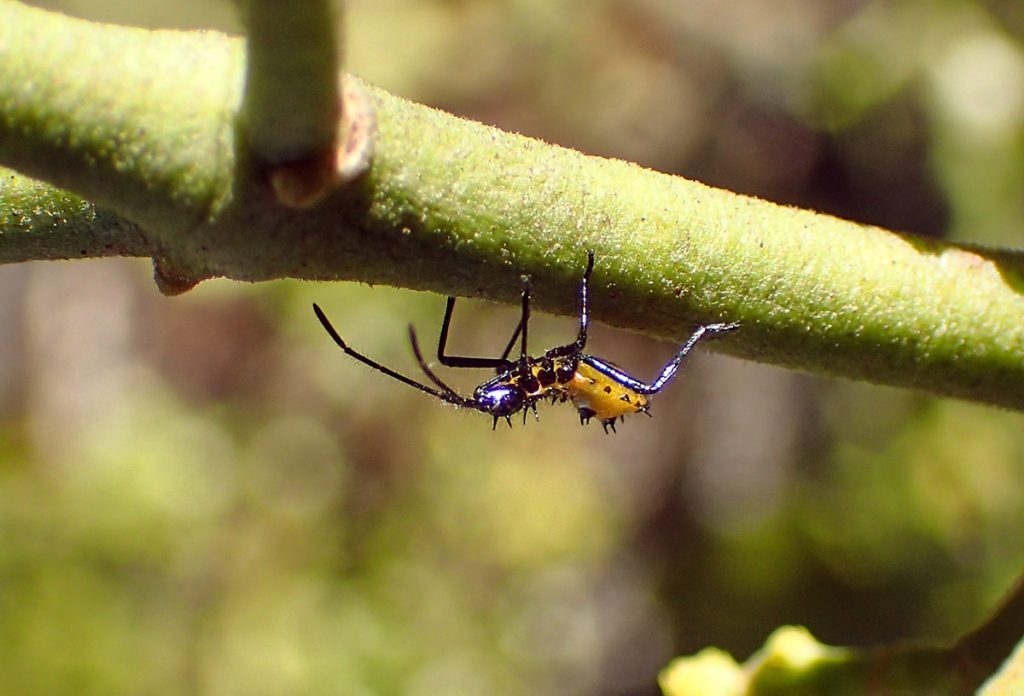
As I photographed the mistletoe, I noticed this small insect on it. True bug nymphs are hard to identify, as many look similar in their early stages. When we shot our mistletoe segment, Leon County IFAS Extension agent Mark Tancig spotted what turned out to be assassin bug eggs. Might this also be an assassin bug?
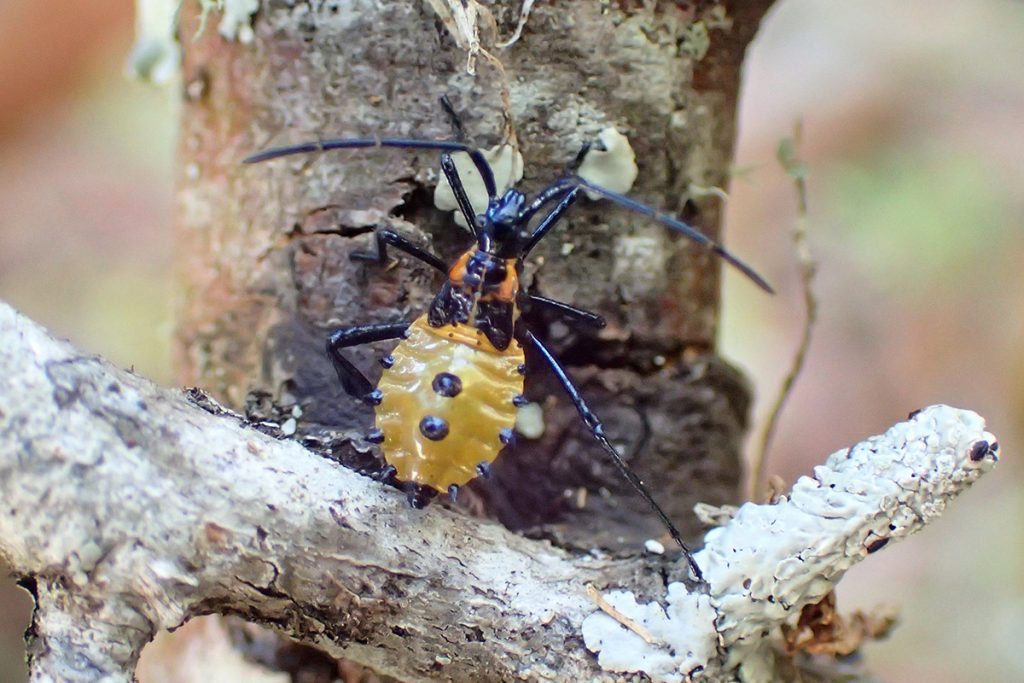
I found a second, larger true bug nymph. I entered them both into iNaturalist separately, and it could be a leaf footed bug or an assassin. I don’t have a definitive answer.
Edit- 1/8/2021: An iNaturalist user has suggested a leaf footed bug in the Leptoglossus genus. That’s the same genus as the leaf footed bug I saw a couple weeks earlier, and a different leaf footed bug I saw in October.
Also this morning, I noticed that something has been digging around on the bare patches in our yard. It’s been happening every now and then, starting in the fall. I’m guessing some sort of mammal is looking for ground nesting insects? Who knows. Maybe I’ll catch it in the act one night.
December 29, 2020
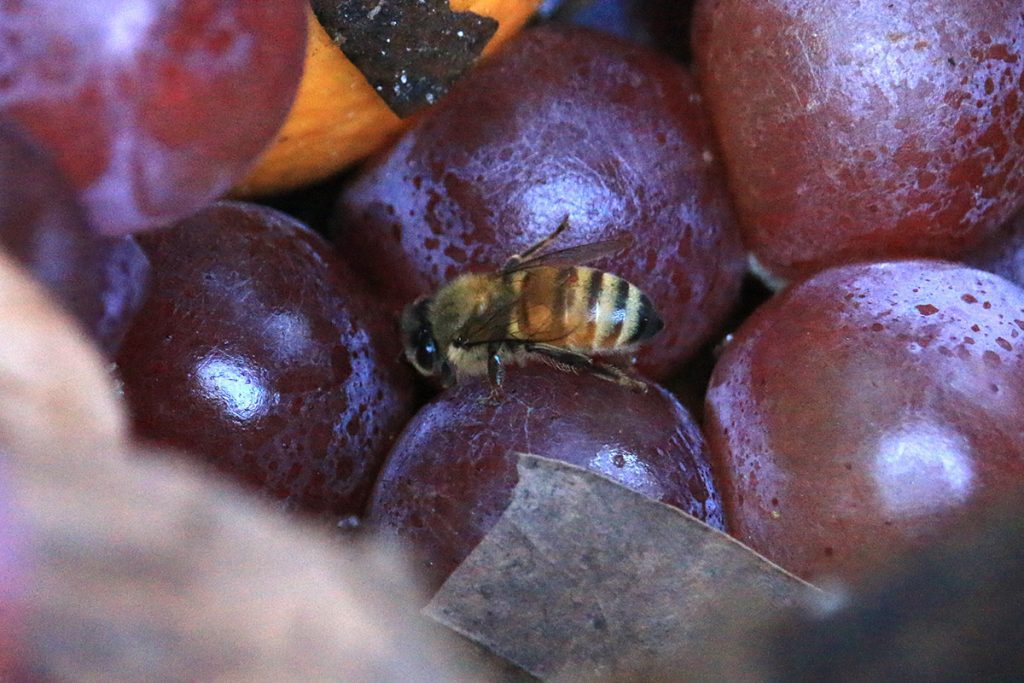
I thought this was neat. I went to turn the compost after dumping some rotting grapes in the night before, and there was a bee crawling around on them. It kept leaving and returning that day and the next. We have some flowers blooming in the yard, but I guess these grapes were more appetizing to the bee? Something to remember on warm winter days we don’t have much available nectar. I know rotting bananas are popular with butterflies.
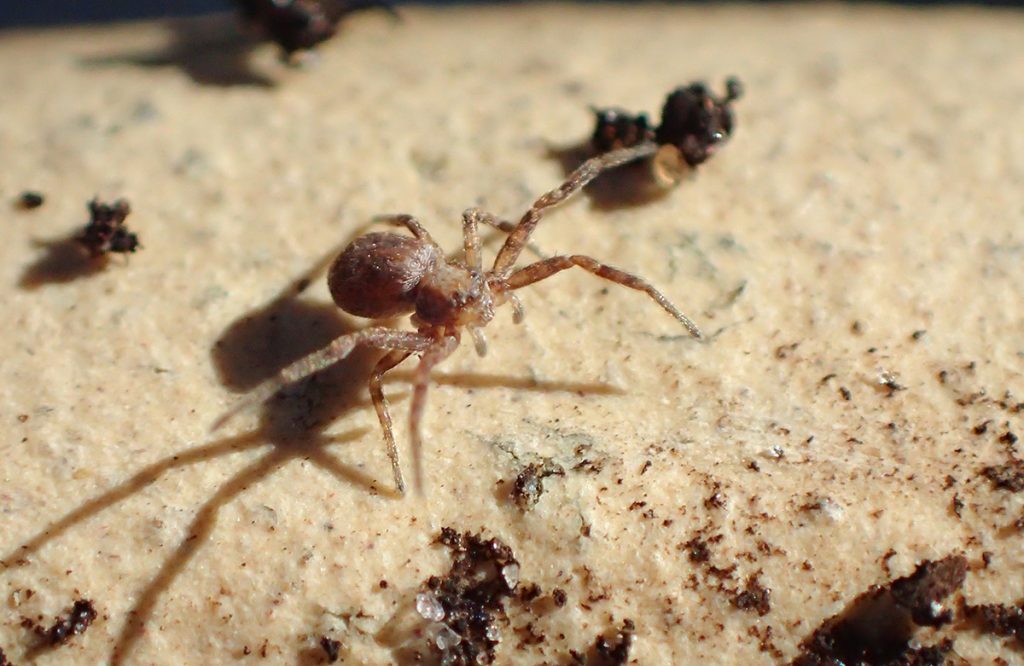
I saw this small spider running around the rim of a pot.
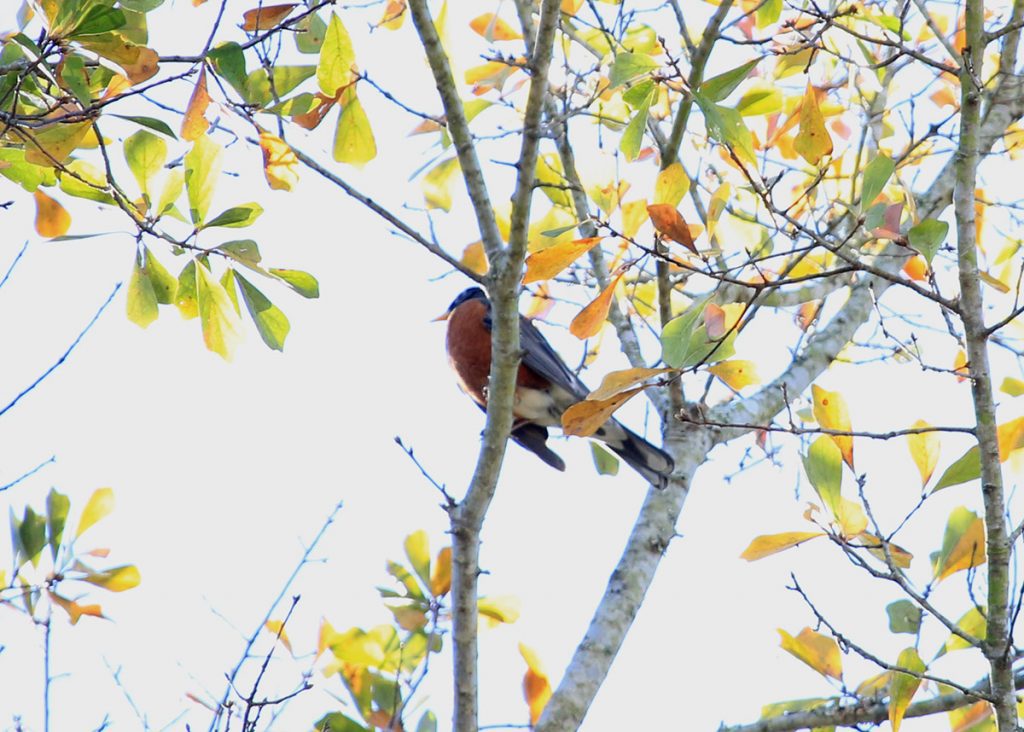
I heard a bird call different than the ones I typically hear in the yard. Looking around, I spotted this single robin. In the winter, large flocks migrate into our area from the north. And, in previous years, whenever I saw a single robin in the yard we were soon to see many more…
December 30, 2020
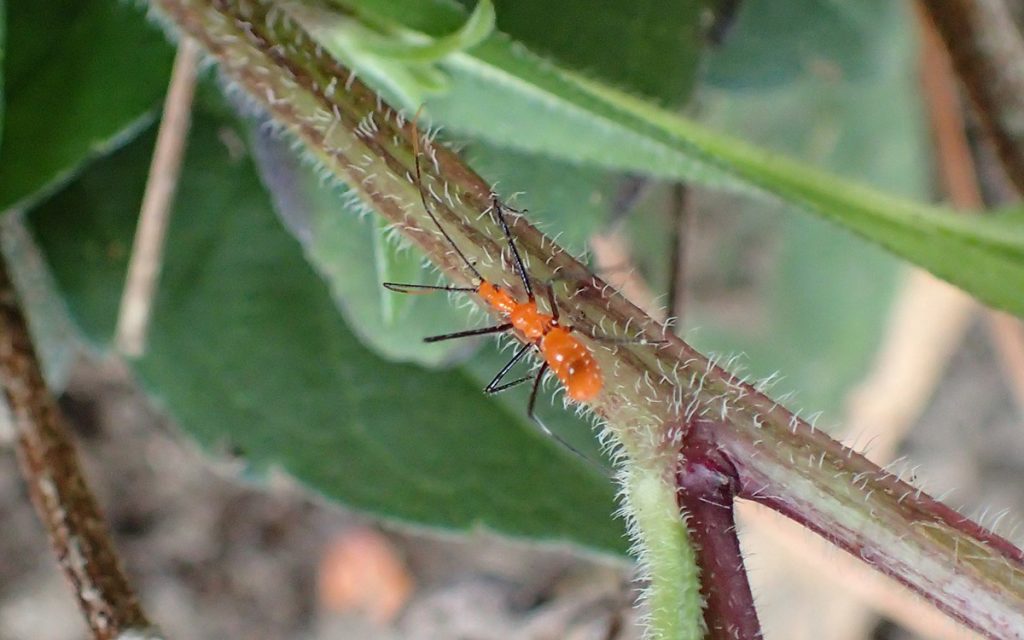
Another true bug nymph, but of a different species than the ones on the mistletoe. This is a brown-eyed Susan plant.
Edit 1/8/2021: Based on the photos I saw of the genus, I had originally selected the Assassin bug genus Zelus for this insect. Another user suggested Zelus longipes, the milkweed assassin bug. The plant above is next to two aquatic milkweed plants.
December 31, 2020 | Flocks of migratory birds to end the year
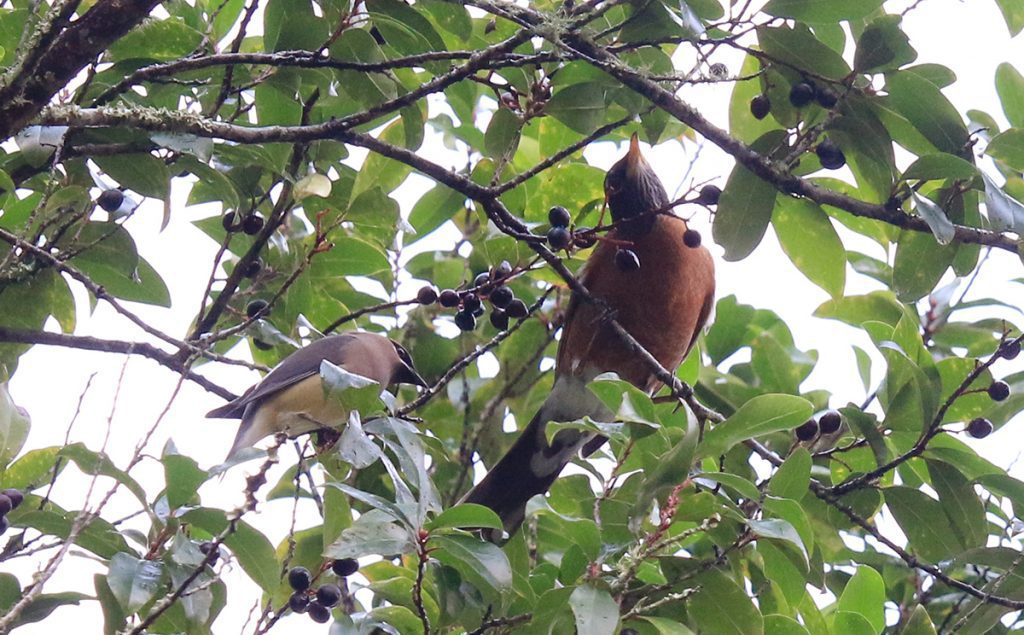
What a ruckus! Not just the tweeting, but the berries and twigs falling and hitting cars and hard objects in ours and the neighbors’ yards. I thought it was just robins until I zoomed in with a camera.
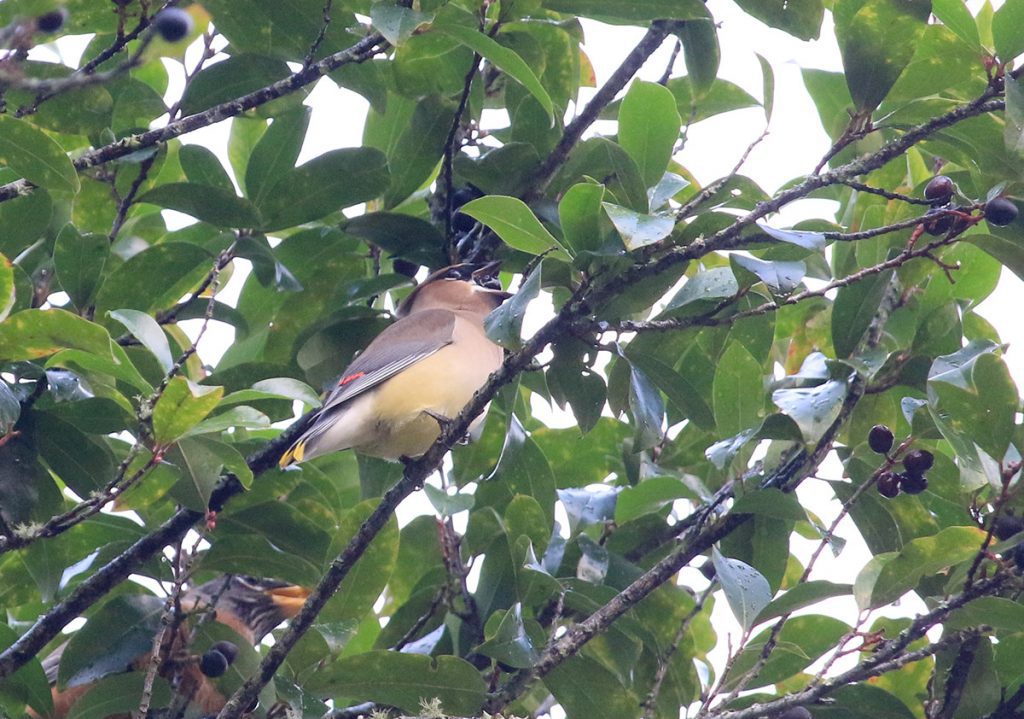
The cedar waxwings didn’t stay as long as the robins.
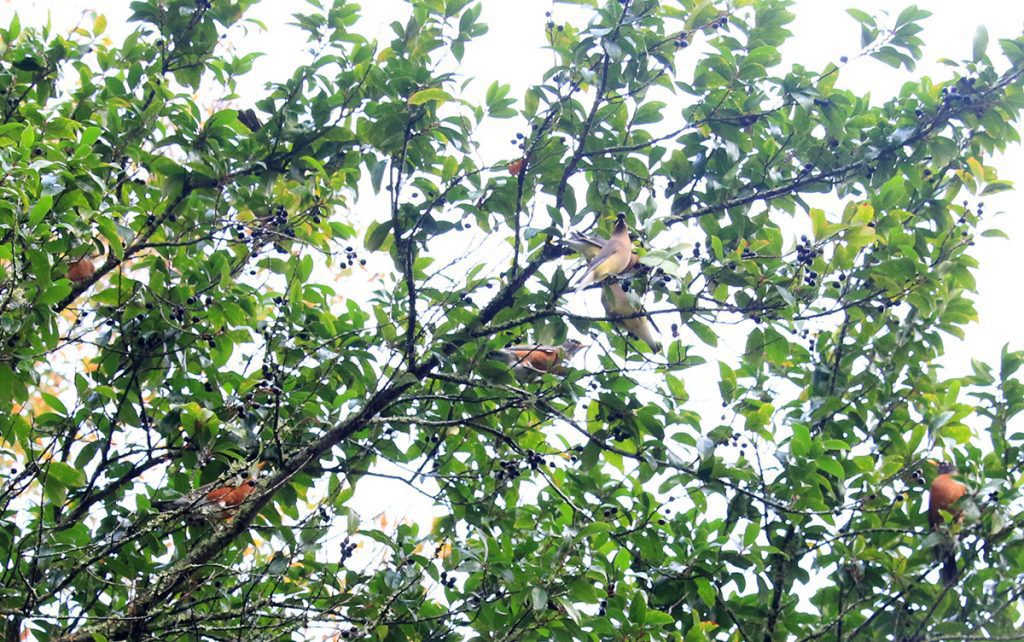
There were many more robins than waxwings, and even after they departed in the morning, I could hear them around the neighborhood, and see them flying overhead, dozens at a time. This is an auspicious way to end a crazy year, I think.
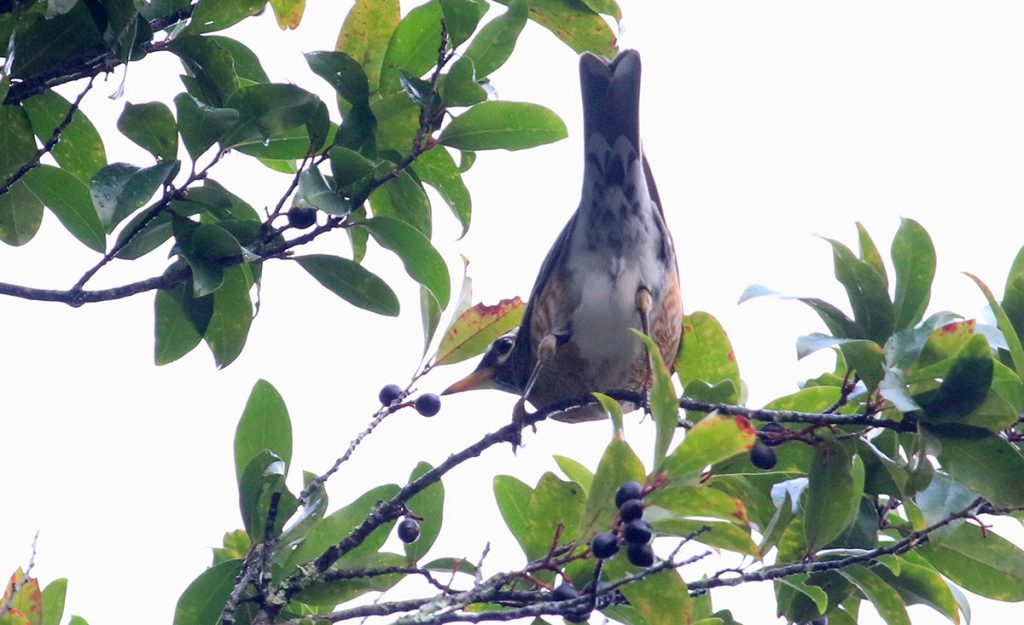
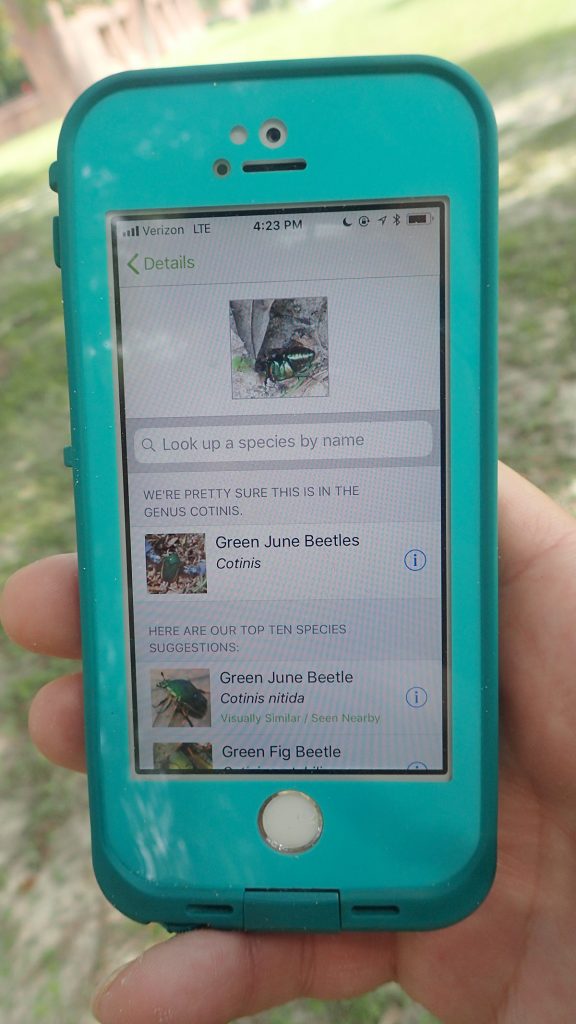
Apps and Citizen Science mentioned in the Backyard Blog
iNaturalist
Identify plants, animals, lichens, and fungi in your yard. Other users correct your identifications if you’re wrong, and even if they don’t, it can be a good springboard to further research.
Seek by iNaturalist
Instant identification, and it doesn’t record your location. This is a good option for kids with phones.
Monarch Larva Monitoring Project
Enter information about monarch caterpillars in your yard, and help researchers get a sense of the health of the monarch population that year, and how and when they’re migrating.
Great Sunflower Project
Record the number of pollinators visiting your flowers, and help researchers map pollinator activity across the country.
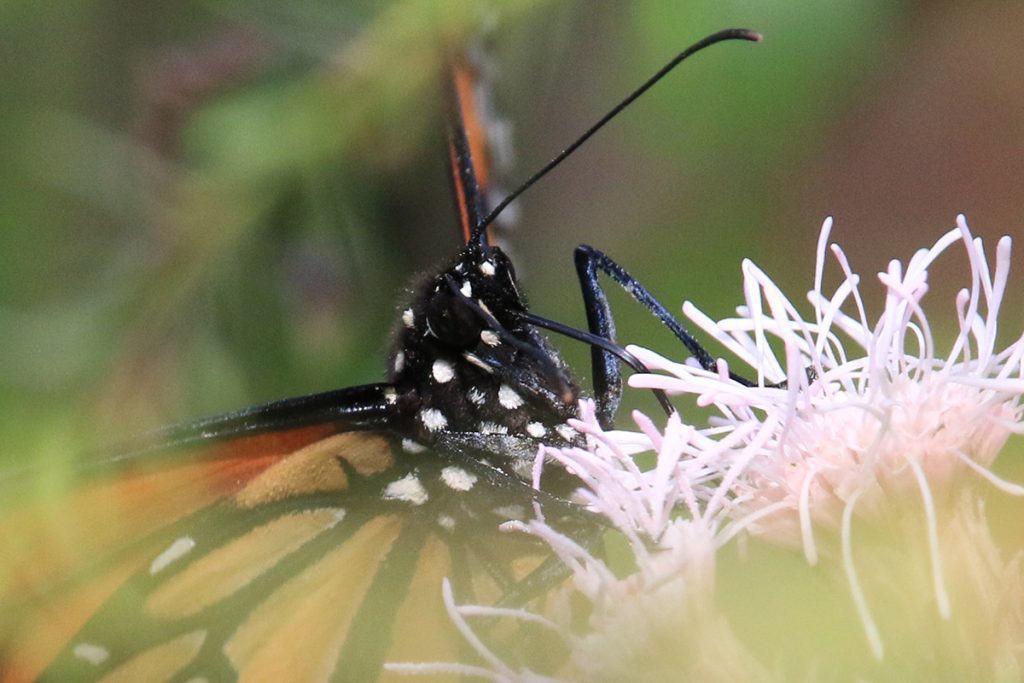
Dig Deeper into Backyard Ecology
What can we do to invite butterflies, birds, and other wildlife into our yards? And what about the flora and fauna that makes its way into our yards; the weeds, insects, and other critters that create the home ecosystem? WFSU Ecology Blog takes a closer look.


